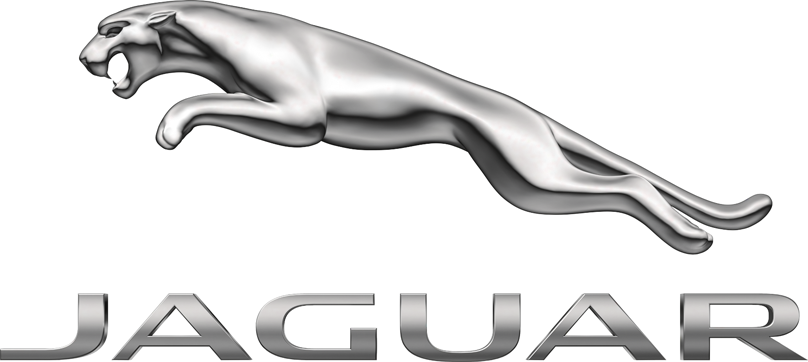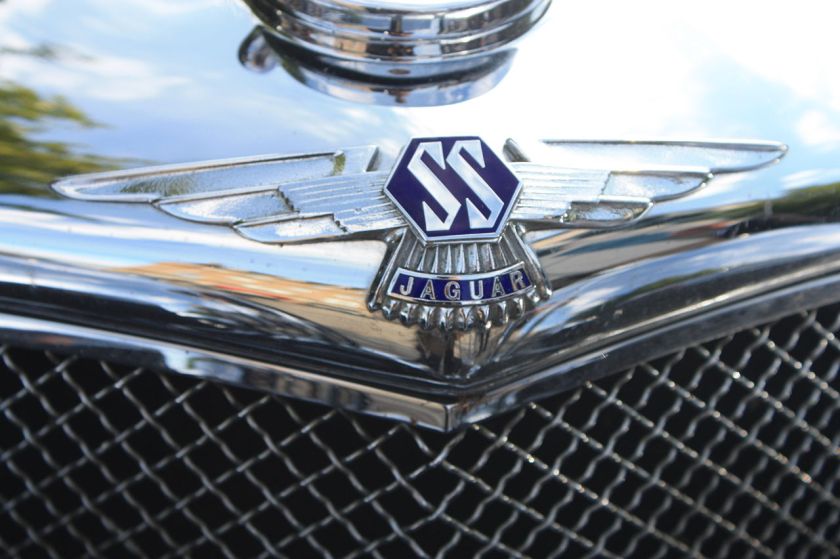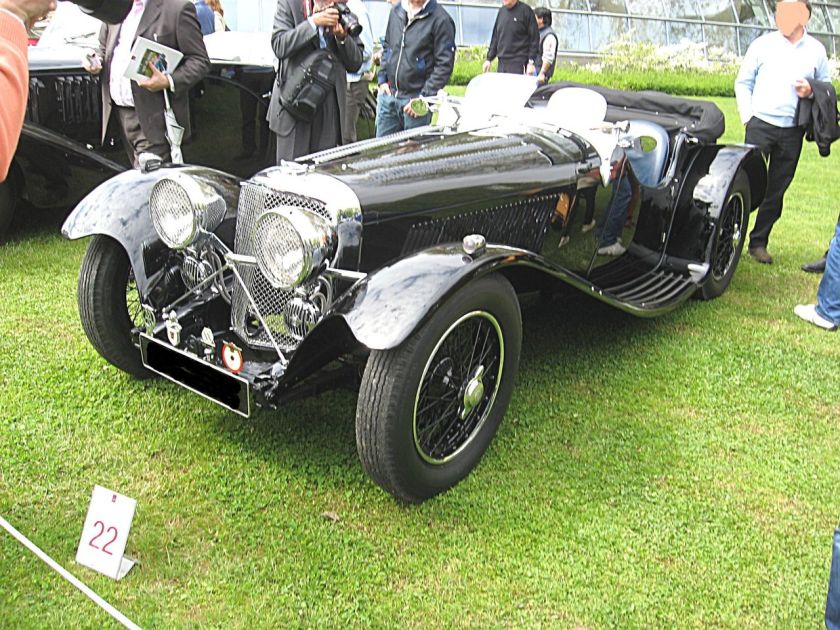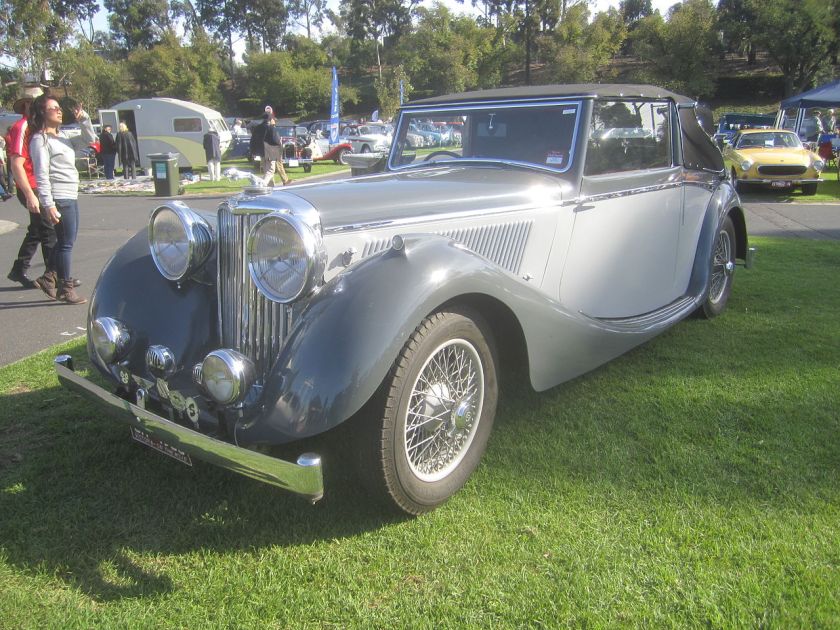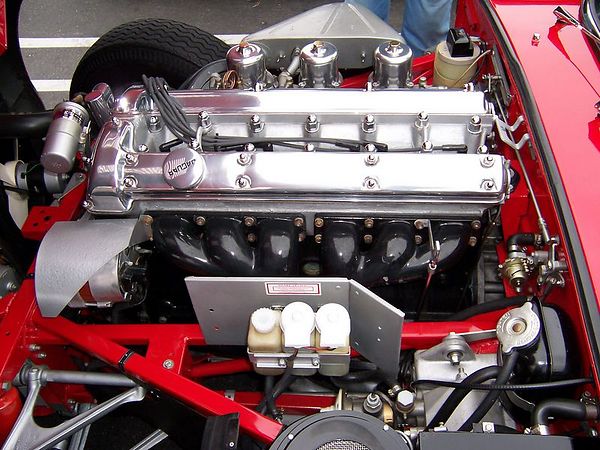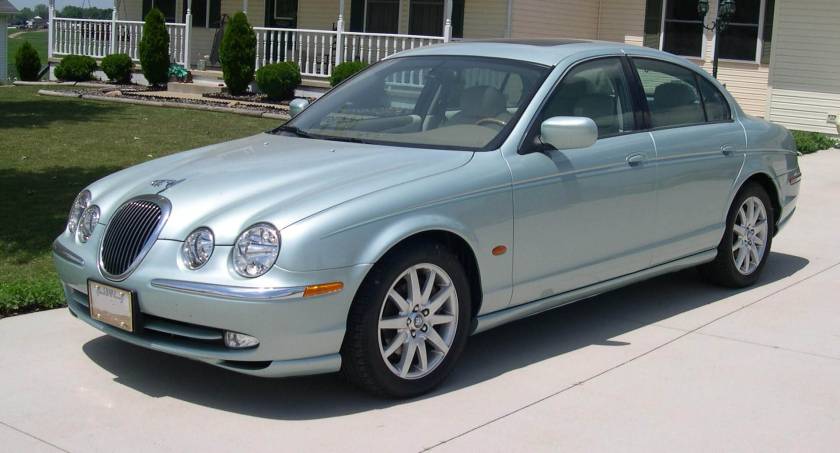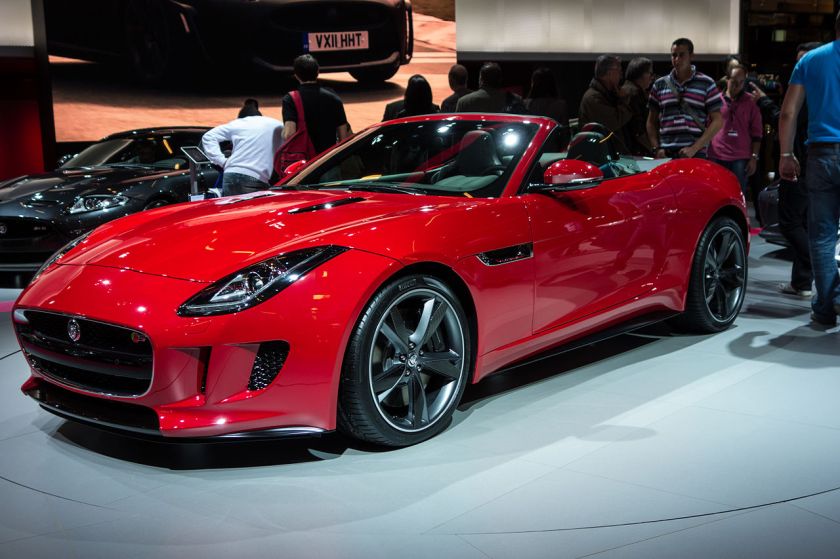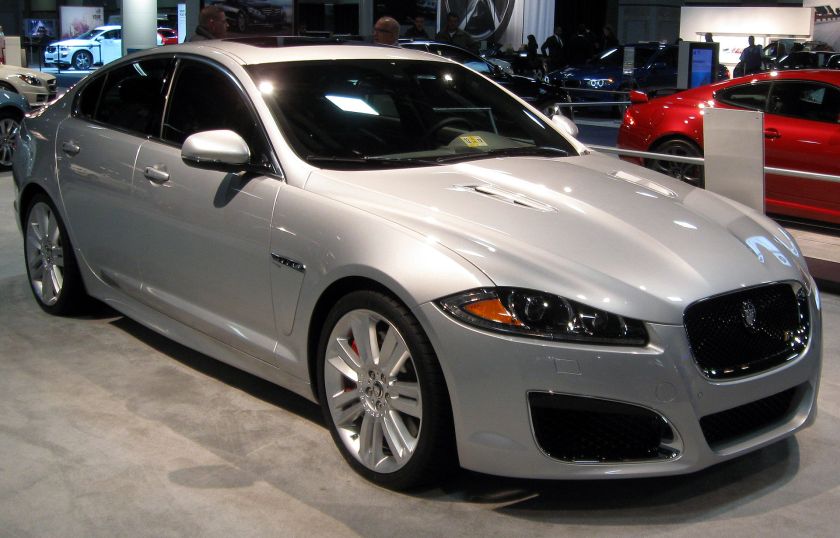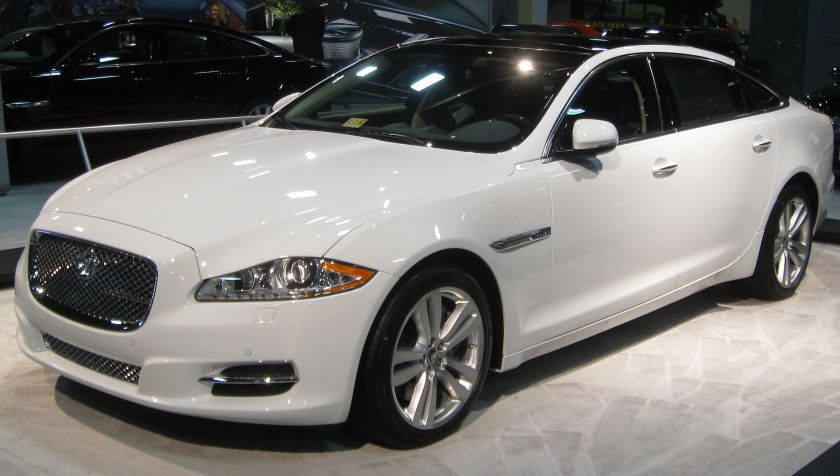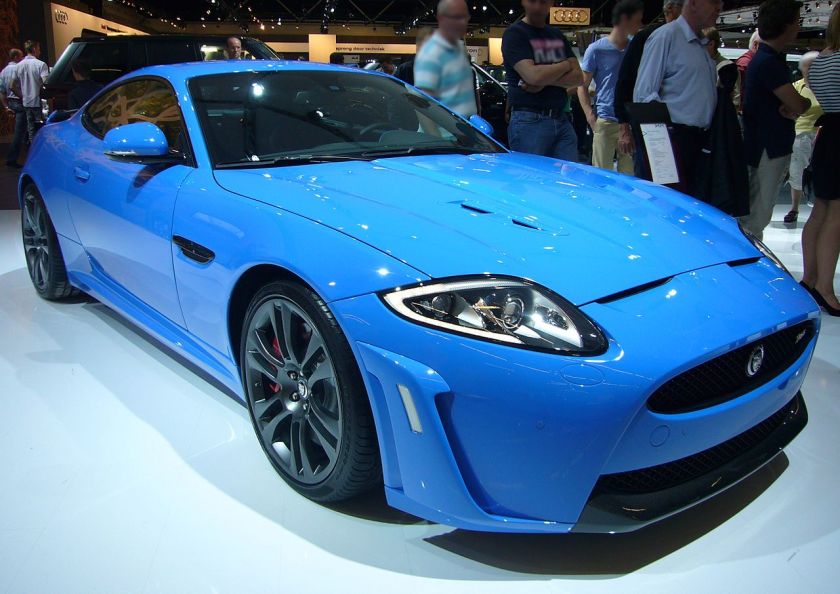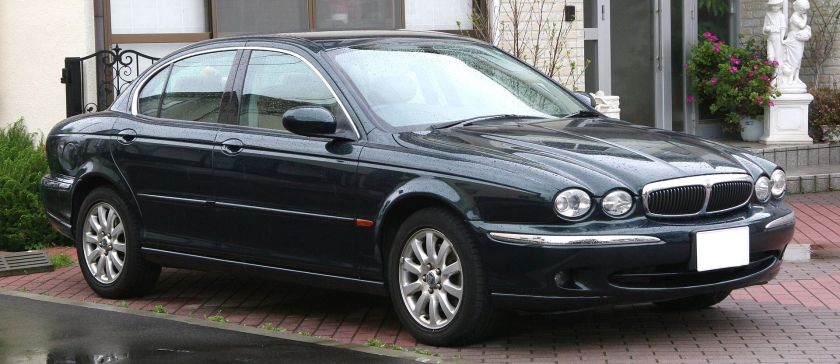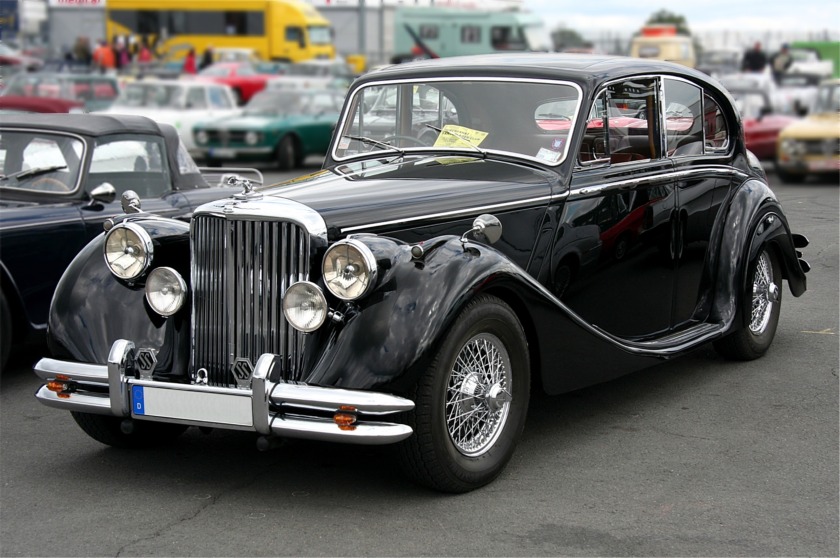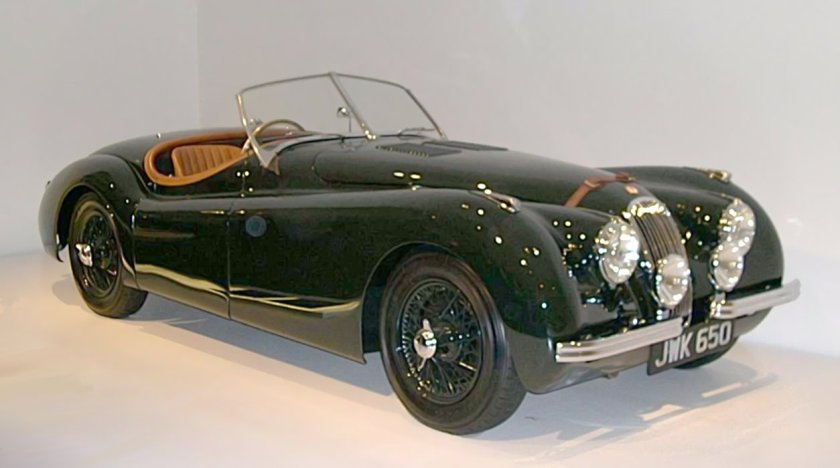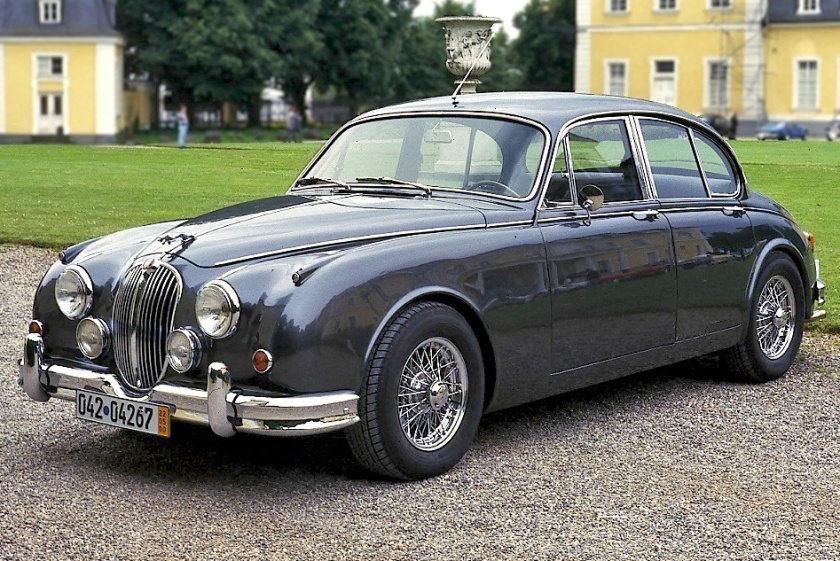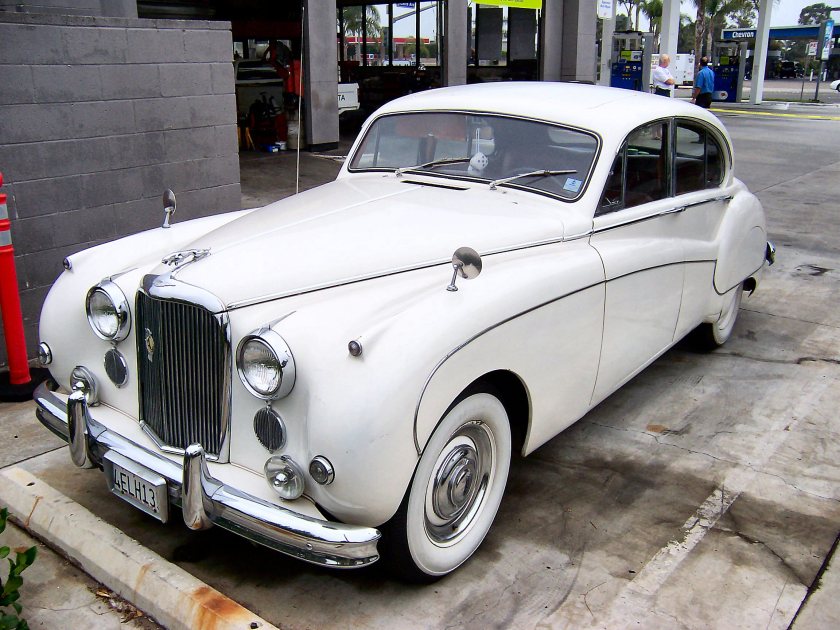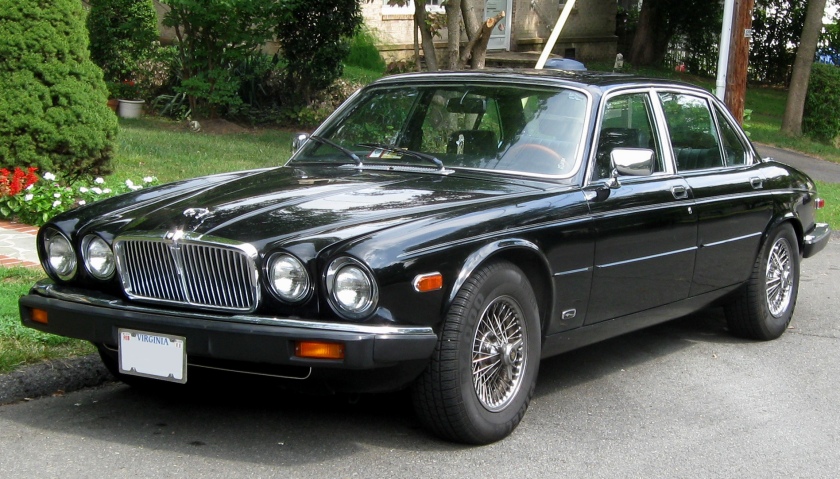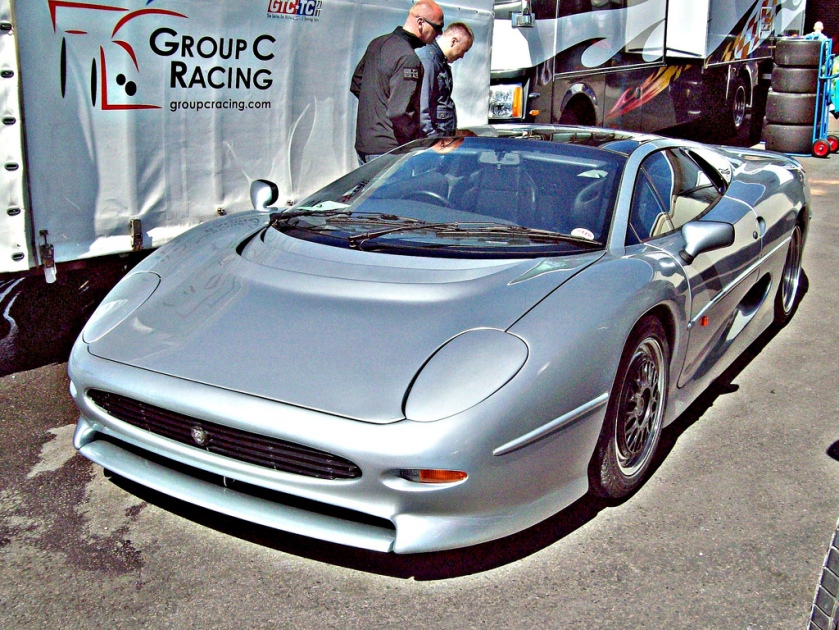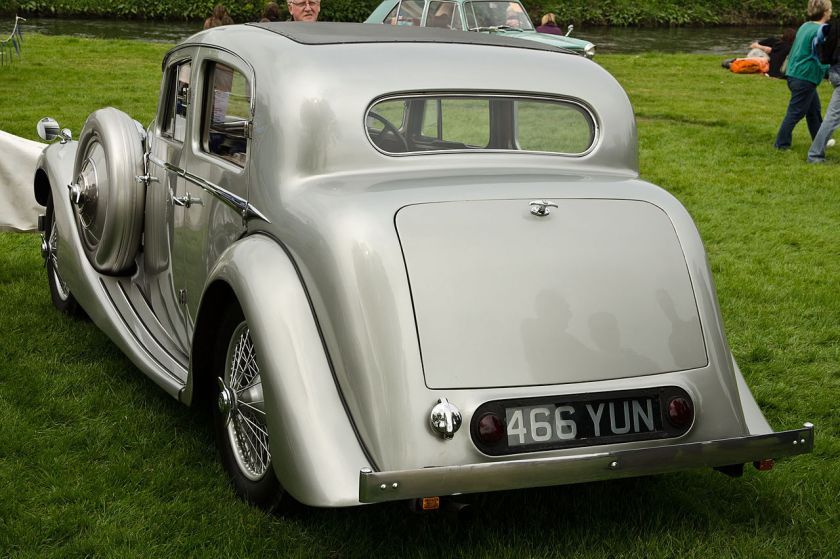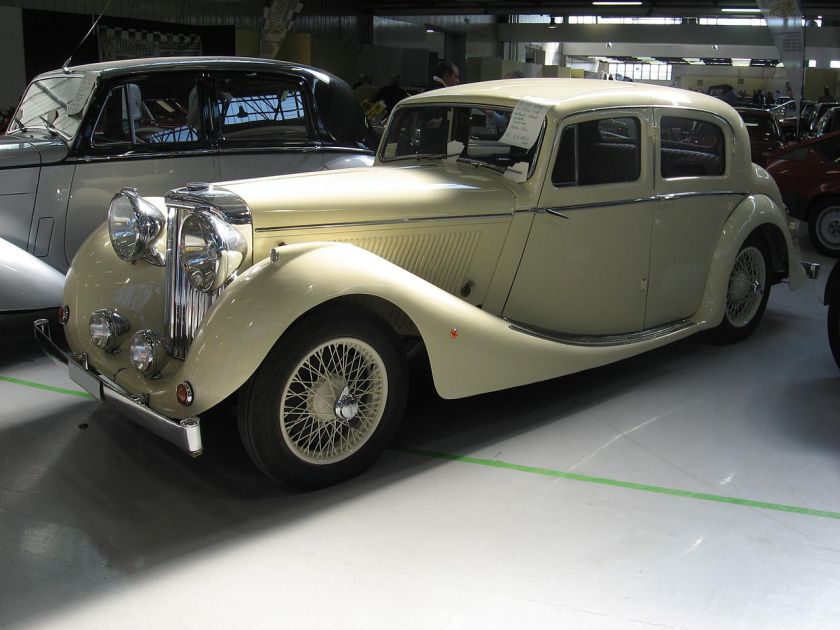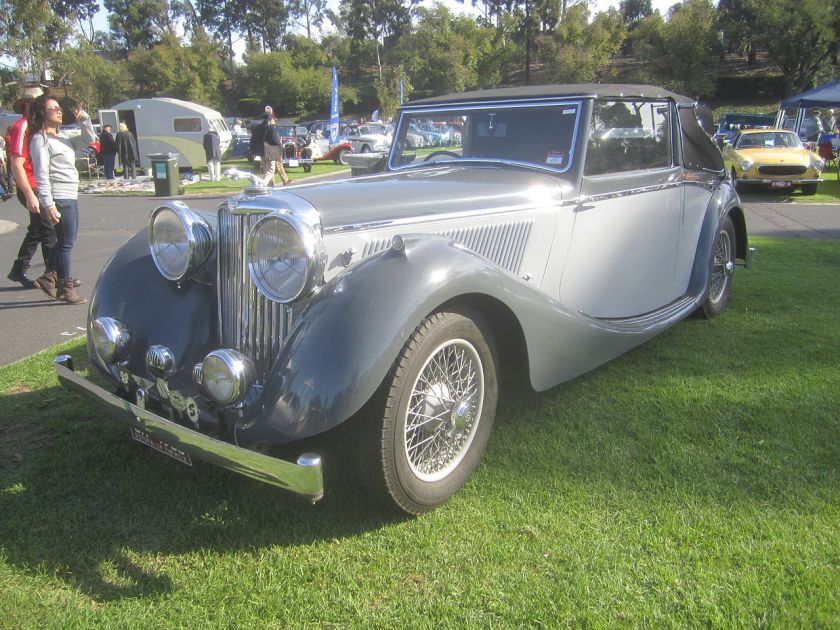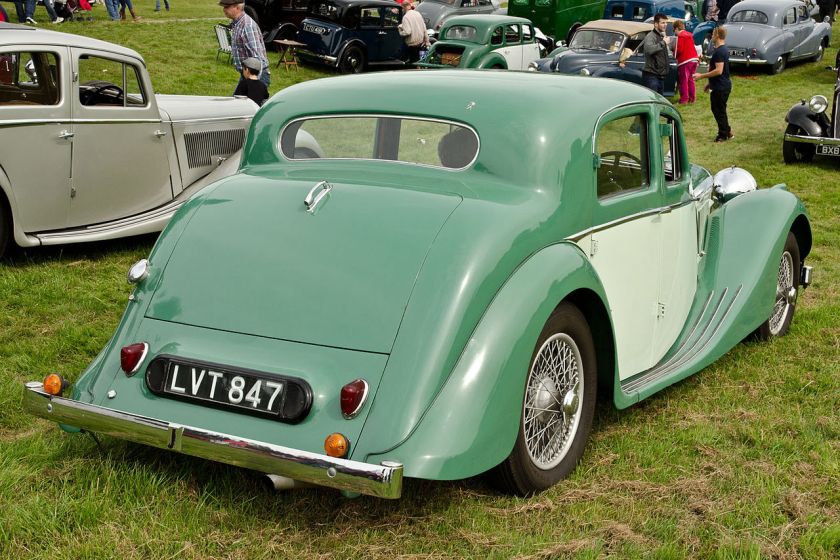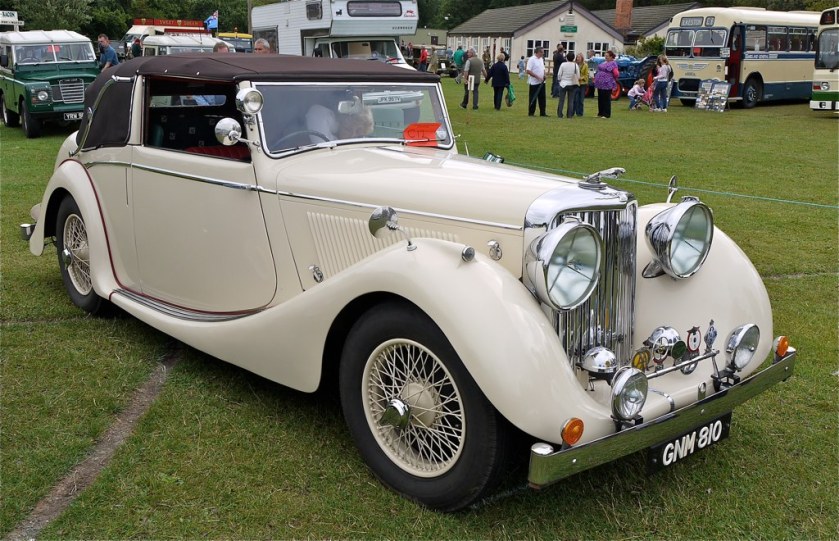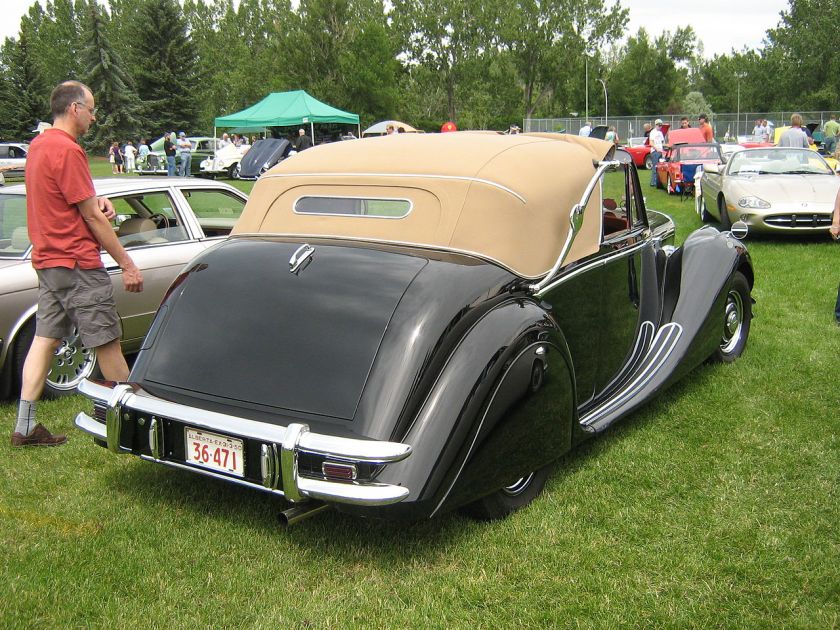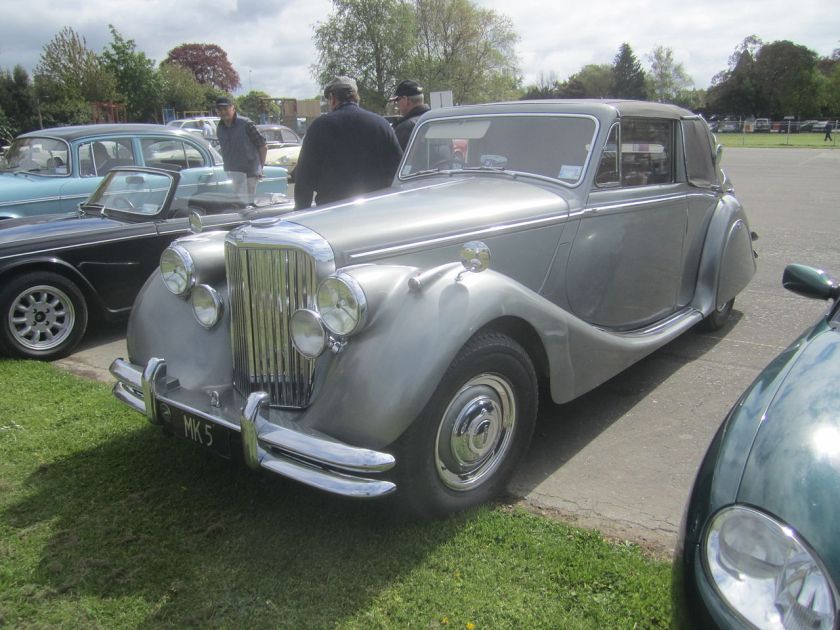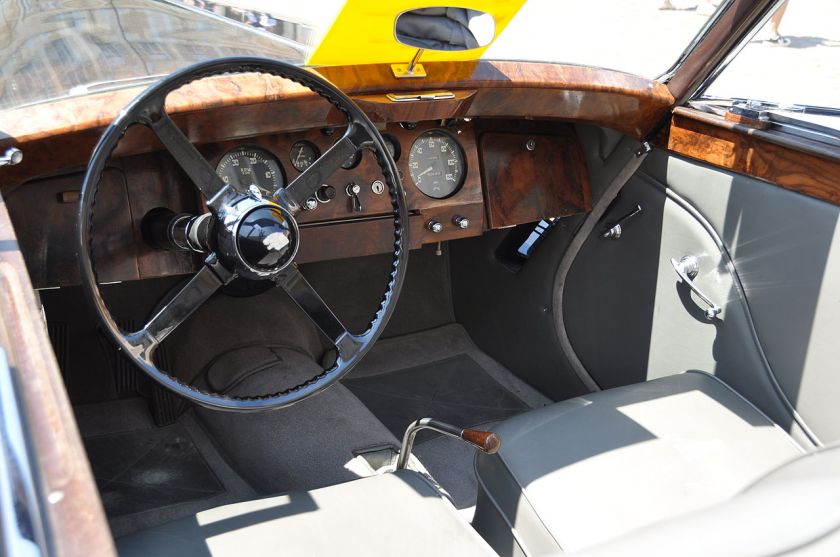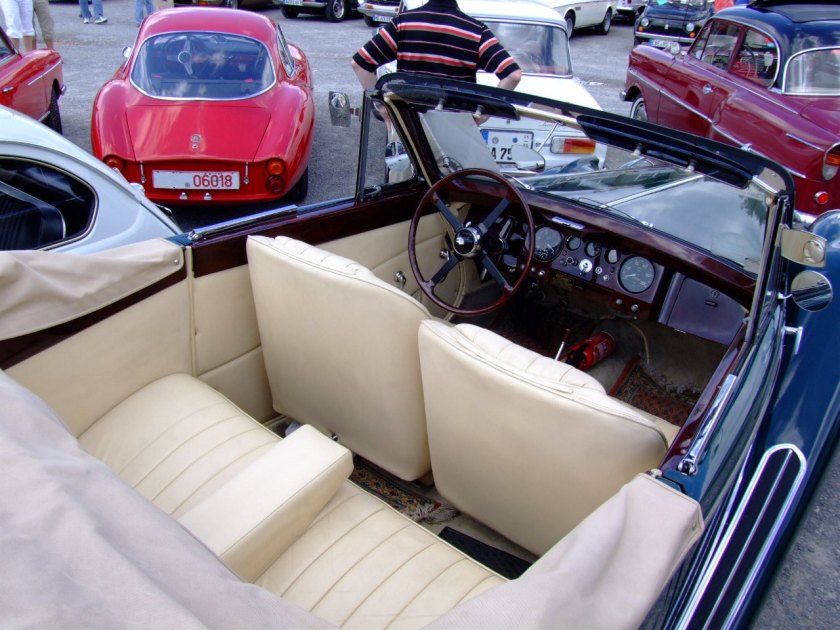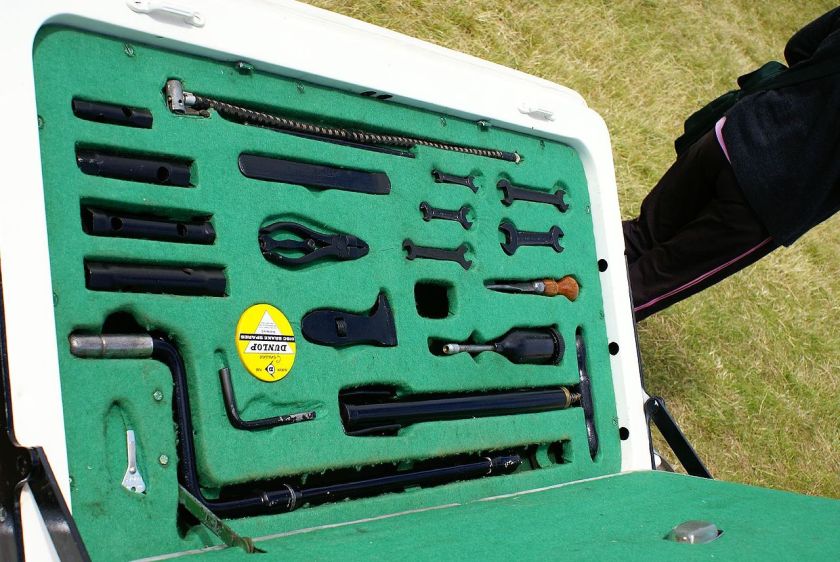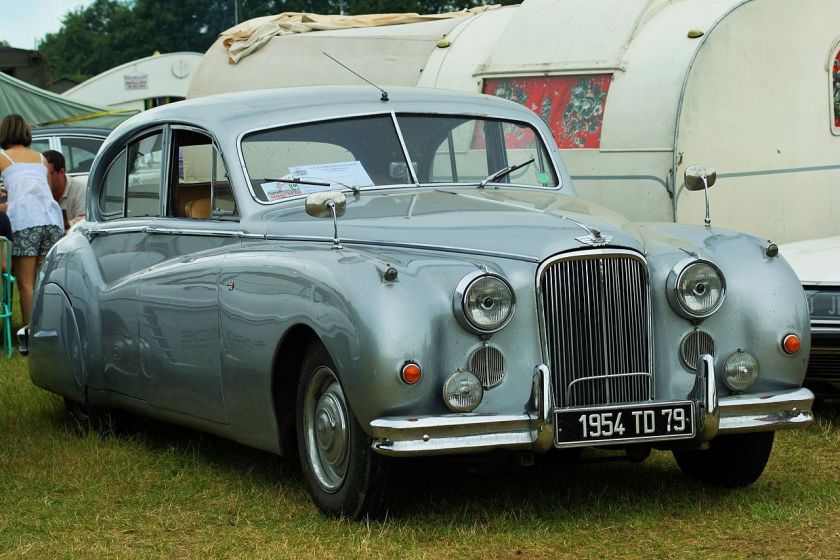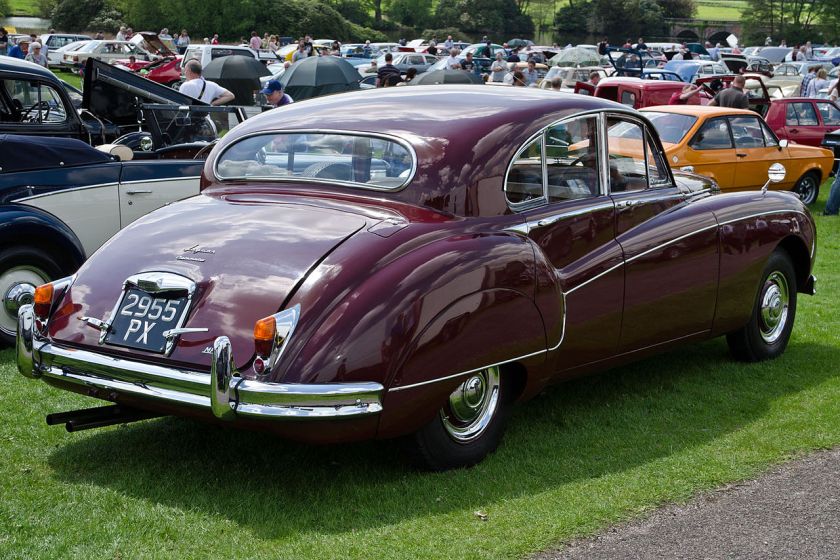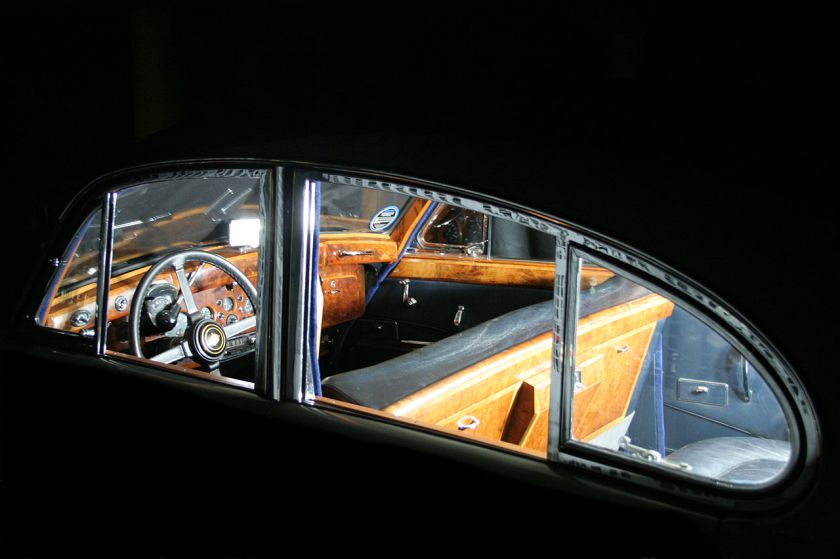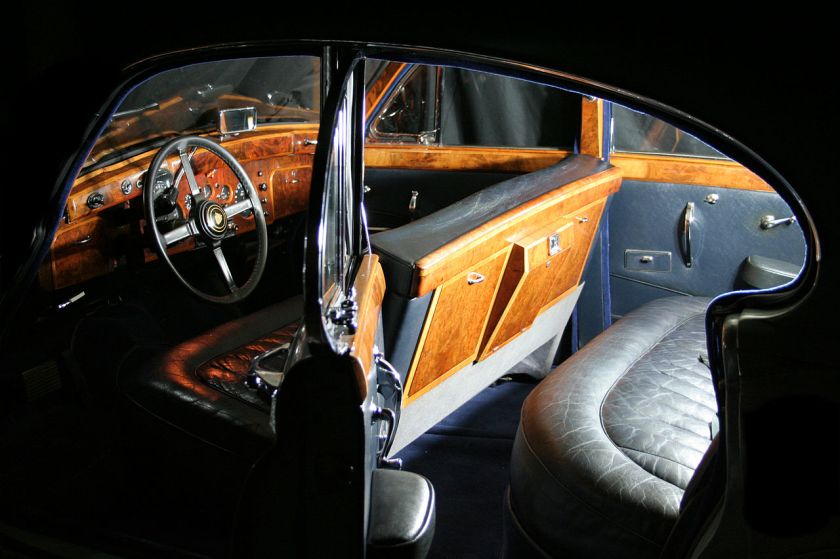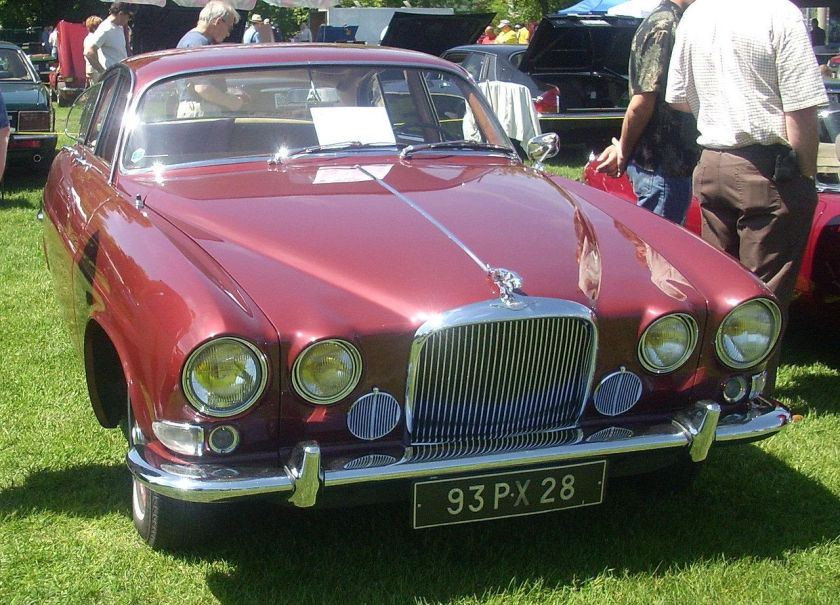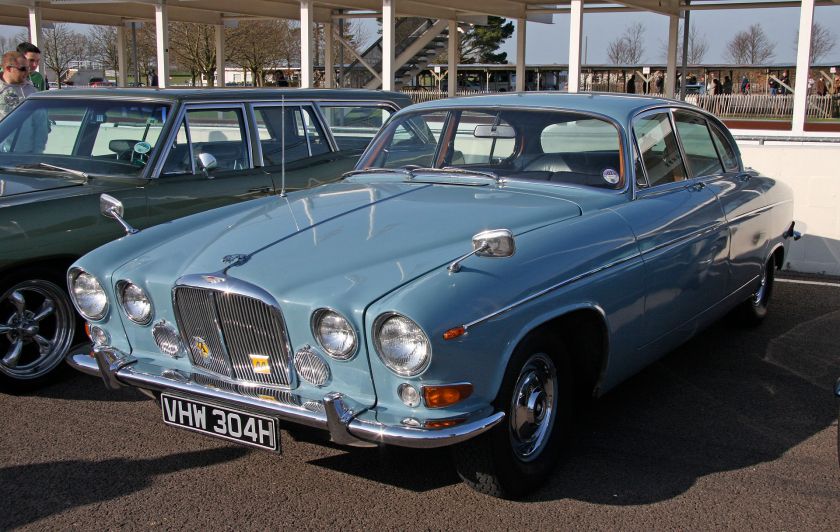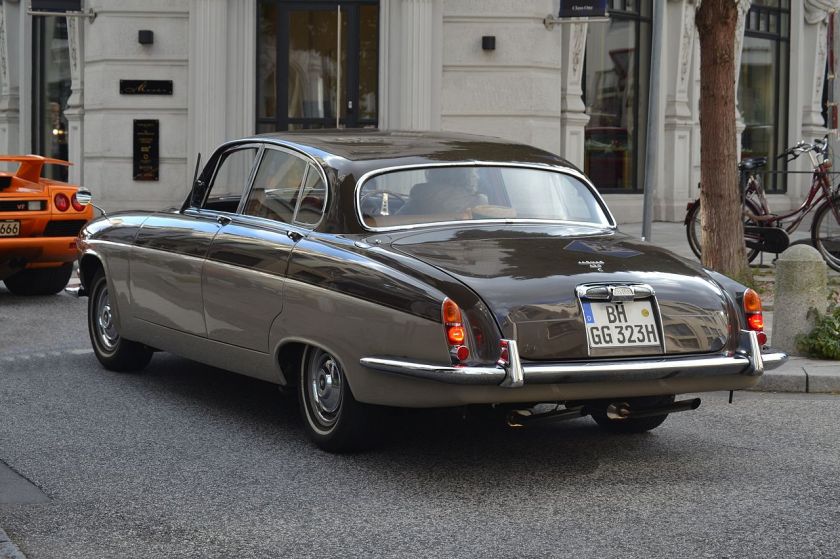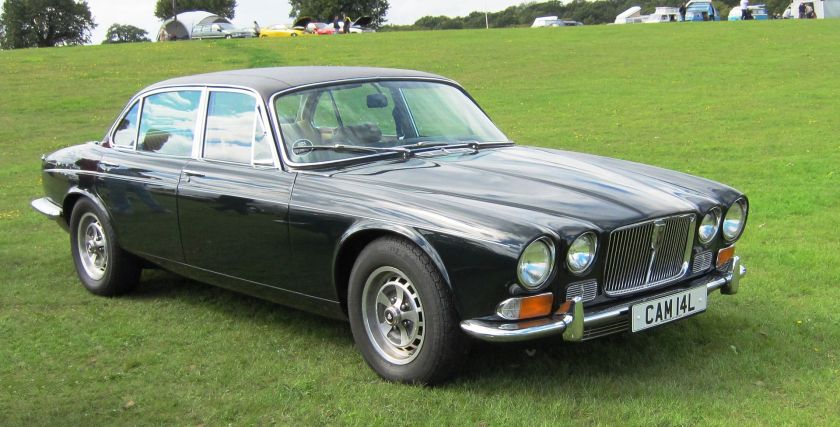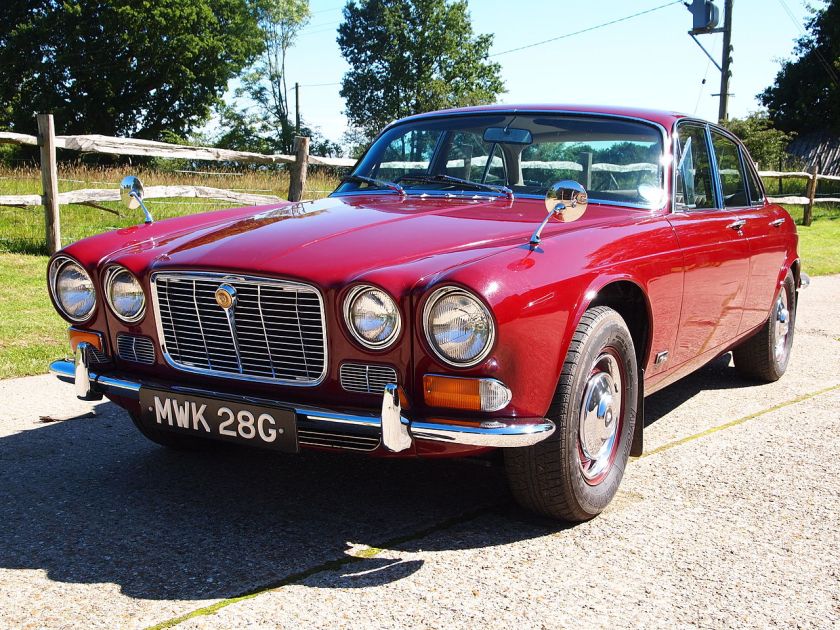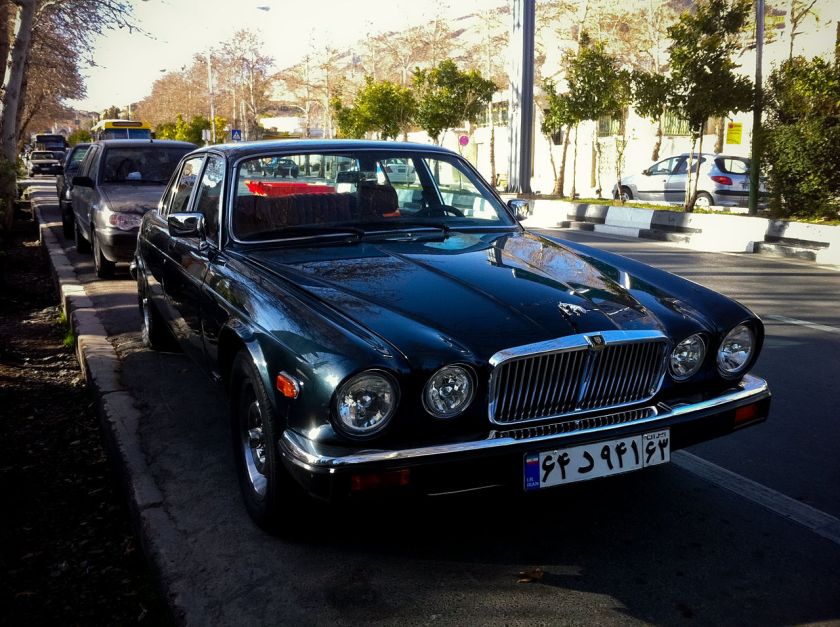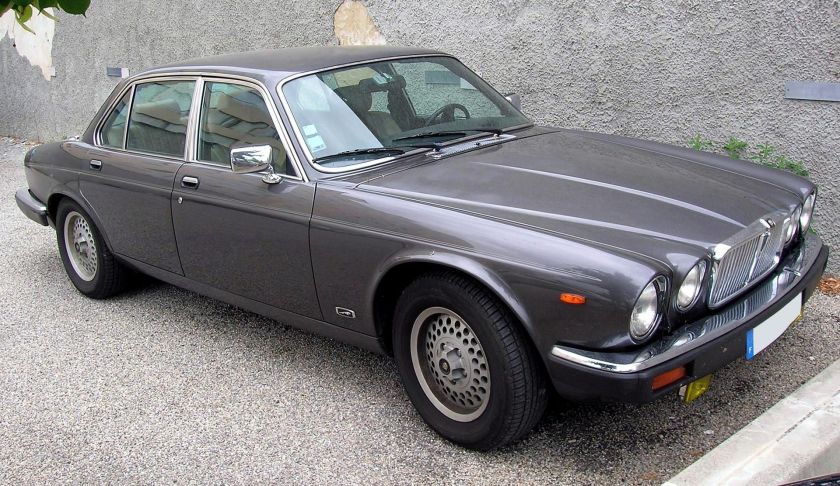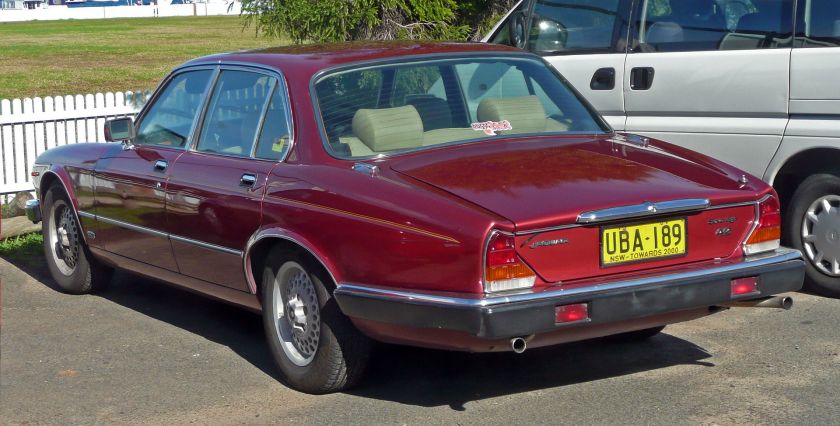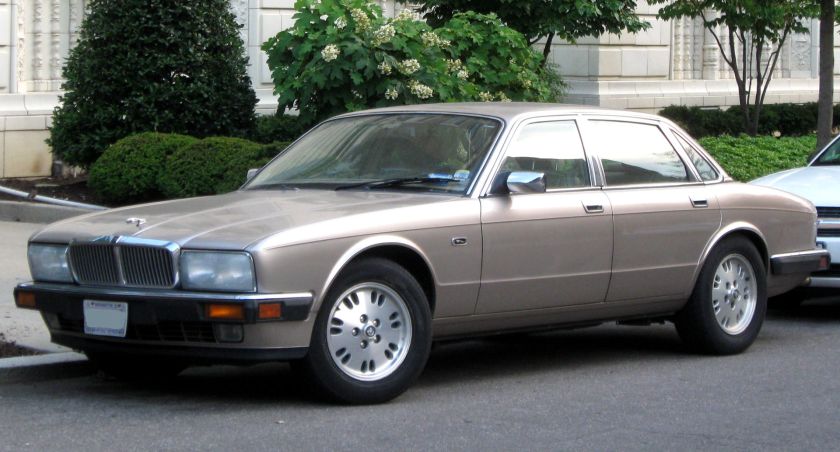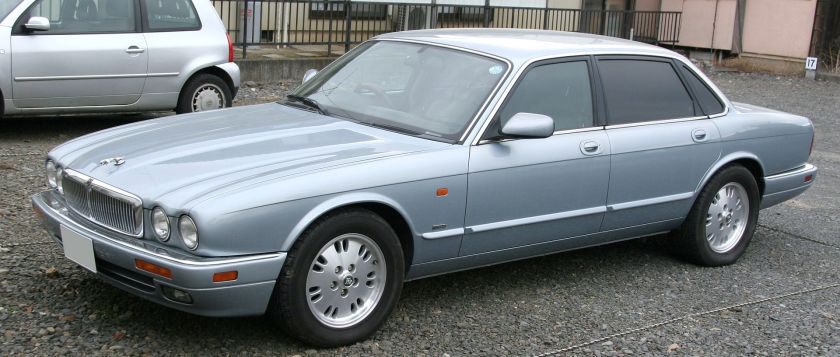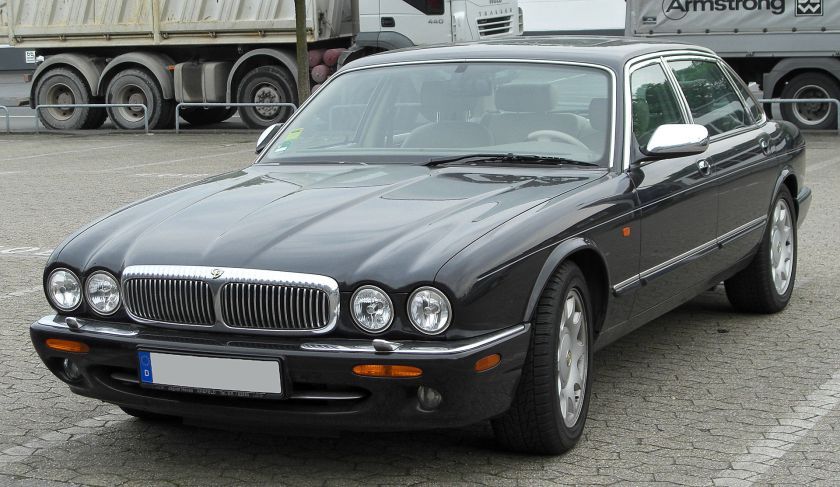Jaguar Cars (/ˈdʒæɡjuː.ər/ jag-ew-ər) is a brand of Jaguar Land Rover, a British multinational car manufacturer headquartered in Whitley, Coventry, England, owned by the Indian company Tata Motors since 2008.
Jaguar was founded as the Swallow Sidecar Company in 1922, originally making motorcycle sidecars before developing passenger cars. The name was changed to “Jaguar” after World War II to avoid the unfavourable connotations of the SS initials. A merger with the British Motor Corporation followed in 1966, the resulting enlarged company now being renamed as British Motor Holdings (BMH), which in 1968 merged with Leyland Motor Corporation and became British Leyland, itself to be nationalised in 1975.
Jaguar was de-merged from British Leyland and was listed on the London Stock Exchange in 1984, becoming a constituent of the FTSE 100 Index until it was acquired by Ford in 1990. Jaguar has, in recent years, manufactured cars for the British Prime Minister, the most recent delivery being an XJ in May 2010. The company also holds royal warrants from Queen Elizabeth II and Prince Charles.
Jaguar cars today are designed in Jaguar Land Rover’s engineering centres at the Whitley plant in Coventry and at their Gaydon site in Warwickshire, and are manufactured in Jaguar’s Castle Bromwich assembly plant in Birmingham with some manufacturing expected to take place in the Solihull plant.
In September 2013 Jaguar Land Rover announced plans to open a 100 million GBP (160 million USD) research and development centre in the University of Warwick, Coventry to create a new generation of vehicle technologies. The carmaker said around 1,000 academics and engineers would work there and that construction would start in 2014.
History
Birth of the cars
The 2½-litre, 68 hp 1935 SS 90
The Swallow Sidecar Company was founded in 1922 by two motorcycle enthusiasts, William Lyons and William Walmsley. leading to SS Cars Ltd. In 1935 the SS Jaguar name first appeared on a 2.5-litre saloon, sports models of which were the SS 90 and SS 100.
Cash was short after World War II, and Jaguar sold the plant and premises of Motor Panels, a pressed steel body manufacturing company they had acquired in the late 1930s when growth prospects seemed more secure. The buyer was Rubery Owen. Nevertheless, Jaguar achieved relative commercial success with their early post war models; times were also tough for other Coventry-based auto-makers and the company was able to buy from John Black‘s Standard Motor Company the plant where Standard had built the six-cylinder engines it had been supplying to Jaguar.
SS Jaguar 3½-litre, 125 hp
drophead coupé 1940
Jaguar made its name by producing a series of successful eye-catching sports cars, the Jaguar XK120 (1948–54), Jaguar XK140 (1954-7), Jaguar XK150 (1957–61), and Jaguar E-Type (1961-75), all embodying Lyons’ mantra of “value for money”. The sports cars were successful in international motorsport, a path followed in the 1950s to prove the engineering integrity of the company’s products.
Jaguar’s sales slogan for years was “Grace, Space, Pace”, a mantra epitomised by the record sales achieved by the MK VII, IX, Mks I and II saloons and later the XJ6. During the time this slogan was used, but the exact text varied.
The core of Bill Lyons’ success following WWII was the twin-cam straight six engine, conceived pre-war and realised while engineers at the Coventry plant were dividing their time between fire-watching and designing the new power plant. It had a hemispherical cross-flow cylinder head with valves inclined from the vertical; originally at 30 degrees (inlet) and 45 degrees (exhaust) and later standardised to 45 degrees for both inlet and exhaust.
As fuel octane ratings were relatively low from 1948 onwards, three piston configuration were offered: domed (high octane), flat (medium octane), and dished (low octane).
The main designer, William “Bill” Heynes, assisted by Walter “Wally” Hassan, was determined to develop the Twin OHC unit. Bill Lyons agreed over misgivings from Hassan. It was risky to take what had previously been considered a racing or low-volume and cantankerous engine needing constant fettling and apply it to reasonable volume production saloon cars.
The subsequent engine (in various versions) was the mainstay powerplant of Jaguar, used in the XK 120, Mk VII Saloon, Mk I and II Saloons and XK 140 and 150. It was also employed in the E Type, itself a development from the race winning and Le Mans conquering C and D Type Sports Racing cars refined as the short-lived XKSS, a road-legal D-Type.
Few engine types have demonstrated such ubiquity and longevity: Jaguar used the Twin OHC XK Engine, as it came to be known, in the Jaguar XJ6 saloon from 1969 through 1992, and employed in a J60 variant as the power plant in such diverse vehicles as the British Army’s Combat Vehicle Reconnaissance (Tracked) family of vehicles, as well as the Fox armoured reconnaissance vehicle, the Ferret Scout Car, and the Stonefield four-wheel-drive all-terrain lorry. Properly maintained, the standard production XK Engine would achieve 200,000 miles of useful life.
Two of the proudest moments in Jaguar’s long history in motor sport involved winning the Le Mans 24 hours race, firstly in 1951 and again in 1953. Victory at the 1955 Le Mans was overshadowed by it being the occasion of the worst motorsport accident in history. Later in the hands of the Scottish racing team Ecurie Ecosse two more wins were added in 1956 and 1957.
In spite of such a performance orientation, it was always Lyons’ intention to build the business by producing world-class sporting saloons in larger numbers than the sports car market could support. Jaguar secured financial stability and a reputation for excellence with a series of elegantly styled luxury saloons that included the 3 litre and 3½ litre cars, the Mark VII, VIII, and IX, the compact Mark I and 2, and the XJ6 and XJ12. All were deemed very good values, with comfortable rides, good handling, high performance, and great style.
Combined with the trend-setting XK 120, XK 140, and XK 150 series of sports car, and nonpareil E-Type, Jaguar’s elan as a prestige motorcar manufacturer had few rivals. The company’s post-War achievements are remarkable, considering both the shortages that drove Britain (the Ministry of Supply still allocated raw materials) and the state of metallurgical development of the era.
In 1950, Jaguar agreed to lease from the Ministry of Supply the Daimler Shadow 2 factory in Browns Lane, Allesley, Coventry, which at the time was being used by The Daimler Company Limited and moved to the new site from Foleshill over the next 12 months. Jaguar purchased Daimler — not to be confused with Daimler-Benz or Daimler AG—in 1960 from BSA. From the late 1960s, Jaguar used the Daimler marque as a brand name for their most luxurious saloons.
An end to independence
Pressed Steel Company Limited made all Jaguar’s (monocoque) bodies leaving provision and installation of the mechanicals to Jaguar. In mid-1965 British Motor Corporation (BMC), the Austin–Morris combine, bought Pressed Steel. Lyons became concerned about the future of Jaguar, partly because of the threat to ongoing supplies of bodies, and partly because of his age and lack of an heir. He therefore accepted BMC’s offer to merge with Jaguar to form British Motor (Holdings) Limited. At a press conference on 11 July 1965 at the Great Eastern Hotel in London, Lyons and BMC Chairman George Harriman announced, “Jaguar Group of companies is to merge with The British Motor Corporation Ltd., as the first step towards the setting up of a joint holding company to be called British Motor (Holdings) Limited”. In due course BMC changed its name to British Motor Holdings at the end of 1966.
BMH was pushed by the Government to merge with Leyland Motor Corporation Limited, manufacturer of Leyland bus and truck, Standard–Triumph and, since 1967, Rover vehicles. The result was British Leyland Motor Corporation, a new holding company which appeared in 1968, but the combination was not a success. A combination of poor decision making by the board along with the financial difficulties of, especially, the Austin-Morris division (previously BMC) led to the Ryder Report and to effective nationalisation in 1975.
Temporary return to independence
Over the next few years it became clear that because of the low regard for many of the group’s products insufficient capital could be provided to develop and begin manufacture of new models, including Jaguars, particularly if Jaguar were to remain a part of the group.
In July 1984, Jaguar was floated off as a separate company on the stock market – one of the Thatcher government’s many privatisations– to create its own track record.
Installed as chairman in 1980, Sir John Egan is credited for Jaguar’s unprecedented prosperity immediately after privatisation. In early 1986 Egan reported he had tackled the main problems that were holding Jaguar back from selling more cars: quality control, lagging delivery schedules, poor productivity, and laid off about a third of the company’s 10,000-some employees to cut costs. Commentators have since pointed out he exploited an elderly model range on which all development costs had been written off and raised prices as well as intensifying the push to improve Jaguar’s quality but in the USA the price rises were masked by a favourable exchange rate.
Ford Motor Company era
Jaguar S-Type based on the Ford DEW98 platform
Ford made offers to Jaguar’s US and UK shareholders to buy their shares in November 1989; Jaguar’s listing on the London Stock Exchange was removed on 28 February 1990. In 1999 it became part of Ford’s new Premier Automotive Group along with Aston Martin, Volvo Cars and, from 2000, Land Rover. Under Ford’s ownership, Jaguar never made a profit.
Under Ford’s ownership Jaguar expanded its range of products with the launch of the S-Type in 1999 and X-type in 2001. Since Land Rover’s May 2000 purchase by Ford, it has been closely associated with Jaguar. In many countries they share a common sales and distribution network (including shared dealerships), and some models now share components, although the only shared production facility was Halewood Body & Assembly, for the X-Type and the Freelander 2. However operationally the two companies were effectively integrated under a common management structure within Ford’s PAG.
On 11 June 2007, Ford announced that it planned to sell Jaguar, along with Land Rover and retained the services of Goldman Sachs, Morgan Stanley and HSBC to advise it on the deal. The sale was initially expected to be announced by September 2007, but was delayed until March 2008. Private equity firms such as Alchemy Partners of the UK, TPG Capital, Ripplewood Holdings (which hired former Ford Europe executive Sir Nick Scheele to head its bid), Cerberus Capital Management and One Equity Partners (owned by JP Morgan Chase and managed by former Ford executive Jacques Nasser) of the US, Tata Motors of India and a consortium comprising Mahindra and Mahindra (an automobile manufacturer from India) and Apollo Management all initially expressed interest in purchasing the marques from the Ford Motor Company.
Before the sale was announced, Anthony Bamford, chairman of British excavator manufacturer JCB had expressed interest in purchasing the company in August 2006, but backed out upon learning that the sale would also involve Land Rover, which he did not wish to buy. On Christmas Eve of 2007, Mahindra and Mahindra backed out of the race for both brands, citing complexities in the deal.
Tata Motors era
On 1 January 2008, Ford formally declared that Tata was the preferred bidder. Tata Motors also received endorsements from the Transport And General Worker’s Union (TGWU)-Amicus combine as well as from Ford. According to the rules of the auction process, this announcement would not automatically disqualify any other potential suitor. However, Ford (as well as representatives of Unite) would now be able to enter into detailed discussions with Tata concerning issues ranging from labour concerns (job security and pensions), technology (IT systems and engine production) and intellectual property, as well as the final sale price. Ford would also open its books for a more comprehensive due diligence by Tata. On 18 March 2008, Reuters reported that American bankers Citigroup and JP Morgan would finance the deal with a USD 3 billion loan.
On 26 March 2008, Ford announced that it had agreed to sell its Jaguar and Land Rover operations to Tata Motors of India, and that they expected to complete the sale by the end of the second quarter of 2008. Included in the deal were the rights to three other British brands, Jaguar’s own Daimler, as well as two dormant brands Lanchester and Rover. On 2 June 2008, the sale to Tata was completed at a cost of £1.7 billion.
Assembly plant
The Swallow Sidecar company (SSC) was originally located in Blackpool but moved to Holbrook Lane, Coventry in 1928 when demand for the Austin Swallow became too great for the factory’s capacity. In 1951, having outgrown the original Coventry site they moved to Browns Lane, which had been a wartime “shadow factory” run by The Daimler Company. Today, Jaguars are assembled at Castle Bromwich in Birmingham. The historic Browns Lane plant ceased trim and final operations in 2005, the X350 XJ having already moved to Castle Bromwich two years prior, leaving the XK and S-Type production to Castle Bromwich
In 2000, Ford turned its Halewood plant over to Jaguar following the discontinuation of its long running Escort that year for Jaguar’s new X-Type model. It was later joined by the second-generation Land Rover Freelander 2, from 2007. Jaguars ceased being produced at Halewood in 2009 following the discontinuation of the X-Type; Halewood now becoming a Land Rover-only plant.
A reduced Browns Lane site operates today, producing veneers for Jaguar Land Rover and others, as well as some engineering facilities. A new assembly plant was opened at Pune, India in April 2011.
Jaguar will begin producing the Jaguar XE – the replacement for the X-Type – at Land Rover’s Solihull plant in 2015, the first non-4×4 passenger car to be produced at the plant since the Rover SD1 in the late 1970s.
Current car models
XE
The XE will be the first compact executive Jaguar since the 2009 model year X-Type and will be the first of several Jaguar models to be built using Jaguar’s new modular aluminium architecture, moving the company away from the Ford derived platforms that were used in the past for the X-Type and XF. The use of Jaguar’s own platform will allow the XE to feature either rear-wheel drive or all-wheel drive configurations, and it will become the first car in its segment with an aluminium monocoque structure. Originally announced at the 2014 Geneva Motor Show with sales scheduled for 2015.
F-Type
The F-Type convertible was launched at the 2012 Paris Motor Show, following its display at the Goodwood Festival of Speed in June 2012, and is billed as a successor to the legendary E-Type. In fact, the Series III E-Type already had a successor, in the form of the XJS, which was in turn replaced by the XK8 and XKR. The F-Type nevertheless returns to the 2-seat plan that was lost with the introduction of the Series III E-Type, which was available only in a 2+2-seat configuration. It was developed following the positive reaction to Jaguar’s C-X16 concept car at the 2011 Frankfurt Auto Show. Sales will begin in 2013 with three engine choices; two variants of the AJ126 V6 petrol engine and the AJ133 V8 petrol engine.
XF
The Jaguar XF is a mid-size executive car introduced in 2008 to replace the S-Type. In January 2008, the XF was awarded the What Car? ‘Car of the Year’ and ‘Executive Car of the Year’ awards. The XF was also awarded Car of the Year 2008 from What Diesel? magazine. Engines available in the XF are 2.2-litre I4 and 3.0-litre V6 diesel engines, or 3.0 litre V6 and 5.0-litre V8 petrol engines. The 5.0 Litre engine is available in supercharged form in the XFR. From 2011, the 2.2-litre diesel engine from the Land Rover Freelander was added to the range as part of a facelift.
XJ
The Jaguar XJ is a full-size luxury saloon. The model has been in production since 1968 with the first generation being the last Jaguar car to have creative input by the company’s founder, Sir William Lyons. In early 2003, the third generation XJ arrived in showrooms and while the car’s exterior and interior styling were traditional in appearance, the car was completely re-engineered. Its styling attracted much criticism from many motoring journalists who claimed that the car looked old-fashioned and barely more modern than its predecessor, many even citing that the ‘Lyons line’ had been lost in the translation from Mark 2 into Mark 3 XJ, even though beneath the shell lay a highly advanced aluminium construction that put the XJ very near the top of its class.
Jaguar responded to the criticism with the introduction of the fourth generation XJ, launched in 2009. Its exterior styling is a departure from previous XJs, with a more youthful, contemporary stance, following the design shift that came into effect previously with the company’s XF and XK models.
The 5-litre V8 engine in the XJ Supersport can accelerate the car from 0 to 60 mph (0–97 km/h) in 4.7 seconds, and has a UK CO2 emission rating of 289 g/km. To cater to the limousine market, all XJ models are offered with a longer wheelbase (LWB) as an option, which increases the rear legroom.
R models
Jaguar began producing R models in 1995 with the introduction of the first XJR. Powered by a supercharged 6-cylinder engine, the car produced approximately 322 horsepower. With the revamped line of engines, the powerplant would be based on an eight-cylinder engine with supercharger from 1997 to present. The 1997–2003 XJR produced 370 horsepower (276 kW) and 385 pound-feet (522 N·m) of torque, taking the car to 60 mph (97 km/h) in 5 seconds. The new aluminium bodyshell from 2004 to 2009 and increased power to 400 hp (298 kW) and enhanced computer systems decreased the time to 60 mph (97 km/h) to 4.8 seconds. Starting after year 2000, XJRs were equipped with Jaguar’s CATS (Computer Active Technology Suspension), which helped firm up the ride in sporty driving without compromising comfort during day-to-day use.
The first XKR was introduced in 1997 and kept with the same power increases as the XJR except for after 2006 the power in the XKR was boosted to 420 hp (313 kW). The S-Type R had a short production run from 2003 to 2008, and came equipped with the same 400 horsepower (298 kW) supercharged V8 as the other R models. It was replaced by the XFR, featuring a 5.0 L supercharged V8 producing 510 hp (380 kW).
- Jaguar XFR 510 hp (380 kW) mid-size saloon
- Jaguar XKR 510 hp (380 kW) coupé and cabriolet
- Jaguar XFR-S 550 hp (410 kW) mid-size saloon
- Jaguar XKR-S 550 hp (410 kW) coupé and cabriolet
- Jaguar XJR
- Jaguar F-Type R 550 hp (410 kW) coupé
Future models
After years of speculation, Jaguar designer Ian Callum confirmed in early 2012 that there would not be a Jaguar SUV, but suggested that he may be designing a crossover for Jaguar. In 2013 Jaguar announced the C-X17 concept, and in January 2015 announced the Jaguar F-Pace, due for a 2015 debut prior to going on sale in 2016. It will incorporate many cues from the C-X17 concept as the first-ever Jaguar crossover.
Previous models
Recent
2002–2003 Jaguar X-Type saloon
The Jaguar S-Type, first appeared in 1999 and stopped production in 2008. It has now been replaced by the Jaguar XF. Early S-Types suffered from reliability problems but those were mostly resolved by the 2004 model year.
The Jaguar X-Type was a compact executive car launched in 2001, while the company was under Ford ownership. Sharing its platform with a 2000 Ford Mondeo, the X-Type ceased production in 2009.
The Jaguar XK is a luxury grand tourer introduced in 2006, where it replaced the XK8. The XK introduced an aluminium monocoque bodyshell, and was available both as a two-door coupé and two-door cabriolet/convertible. Production ceased in 2014.
The Jaguar company started production with the pre-war 1.5, 2.5 and 3.5-litre models, which used engines designed by the Standard Motor Company. The 1.5-litre four-cylinder engine was still supplied by Standard but the two larger six-cylinder ones were made in house. These cars have become known unofficially as Mark IVs.
The first post-war model was the 1948 Mark V available with either 2.5- or 3.5-litre engines, and it had a more streamlined appearance than pre-war models, but more important was the change to independent front suspension and hydraulic brakes.
The XK120 was a breakthrough both for Jaguar and post-WWII sports cars
The big breakthrough was the launch in 1948 of the XK120 sports car, powered with the new XK twin overhead camshaft (DOHC) 3.5-litre hemi-head six-cylinder engine designed by William Heynes, Walter Hassan and Claude Baily. This engine had been designed at night during the war when they would be on fire watch in the factory. After several attempts a final design was achieved. That is until owner William Lyons said “make it quieter”. The car had originally been intended as a short production model of about 200 vehicles as a test bed for the new engine until its intended home, the new Mark VII saloon, was ready. The XK120’s exceptional reception was followed in 1954 by the introduction of the derivative XK140, and a much revised XK150.
1963 open two-seat E-Type
Jaguar launched the E-Type in 1961.
Along with sports cars, Jaguar maintained a strong place in the upscale saloon car market. Introducing the large Mark VII in 1951, a car especially conceived for the American market, Jaguar was overwhelmed with orders. The Mark VII and its successors gathered rave reviews from magazines such as Road & Track and The Motor. In 1956 a Mark VII won the prestigious Monte Carlo Rally.
The late 1950s Mark 2 became one of the most recognisable Jaguar models ever produced
In 1955, the “2.4-Litre” saloon (subsequently known as the 2.4 Mark 1) was the first monocoque (unitary) car from Jaguar. Its 2.4-litre short-stroke version of the XK engine provided 100 mph (160 km/h) performance. In 1957, the 3.4-litre version with disk brakes, wire wheels and other options was introduced, with a top speed of 120 mph (190 km/h). In 1959, an extensively revised version of the car with wider windows and 2.4, 3.4, and 3.8-litre engine options became the Mark 2. The 3.8 Mark 2 was popular with British police forces for its small size and 125 mph (201 km/h) performance.
Jaguar’s slogan motto of “Grace, Space, Pace” was epitomised in the 1958 Mark IX
The Mark VIII of 1956 and Mark IX of 1958 were essentially updates of the Mark VII, but the Mark X of 1961 was a completely new design of large saloon with all round independent suspension and unitary construction.
The independent rear suspension from the Mark X was incorporated in the 1963 S-Type, which closely resembled the Mark 2, and in 1967 the Mark 2 name was dropped when the small saloon became the 240/340 range. The 420 of 1966, also sold as the Daimler Sovereign, put a new front onto the S-type, although both cars continued in parallel until the S-Type was dropped in 1968. The Mark X became the 420G in 1966.
The XJ6, regarded by many as the definitive Jaguar saloon
Of the more recent saloons, the most significant is the XJ (1968–1992). From 1968 on, the Series I XJ saw minor changes, first in 1973 (to Series II), 1979 (Series III), a complete redesign for 1986/1987 in XJ40, further modifications in 1995 (X300), in 1997 with V8-power (X308), and a major advance in 2003 with an industry-first aluminium monocoque-chassis (X350). The most luxurious XJ models carried either the Vanden Plas (US) or Daimler (rest of world) nameplates. In 1972, the 12-cylinder engine was introduced in the XJ, while simultaneously being offered in the E Type.
The XJ220—the world’s fastest production car in 1992
1992 saw the introduction of the mid-engined, twin-turbo XJ220, powered by a 542 bhp (404 kW; 550 PS) V6 engine. The XJ220 was confirmed the fastest production car in the world at the time after Martin Brundle recorded a speed of 217 mph (349 km/h) on the Nardo track in Italy.
Over the years many Jaguar models have sported the famous chrome plated Leaping Jaguar, traditionally forming part of the radiator cap. Known as “The Leaper” this iconic mascot has been the subject of controversy in recent times when banned for safety reasons from cars supplied to Europe whilst it continued to be fitted on cars destined for the United States, Middle East and Far East. It has now been dropped from all the latest Jaguar models.
Complete line-up
Large executive
- 1935–1955 2½ Litre saloon
1935-1949 Jaguar Mark IV
| SS Jaguar Jaguar 1½—2½—3½ Litre |
|
|---|---|
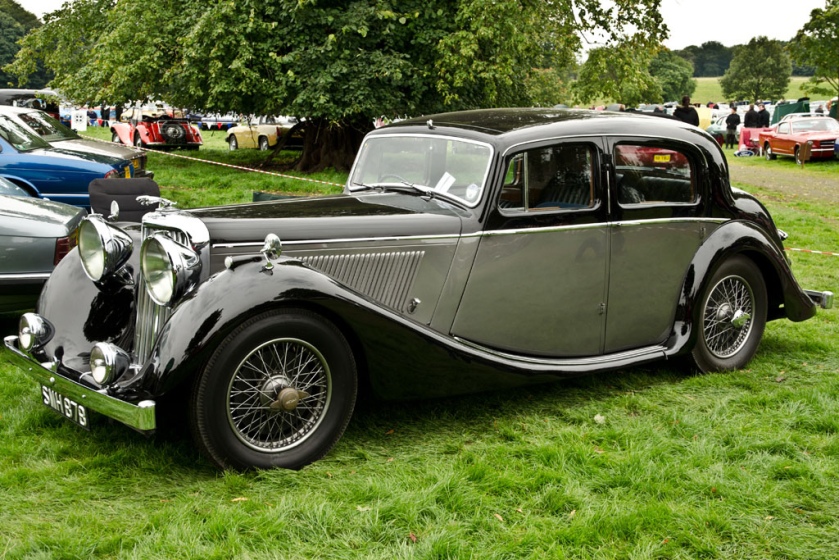
Jaguar 2½ litre sports saloon 1947
|
|
| Overview | |
| Manufacturer | |
| Production | 1935–1949 |
| Assembly | Coventry, England |
| Layout | FR layout |
| Chronology | |
| Predecessor | SS Cars Ltd SS1 |
| Successor | Jaguar Mark V |
The Jaguar Mark IV (pronounced mark four) is an automobile built by Jaguar Cars from 1945 to 1949. It was a relaunch of the SS Jaguar 1½ litre, 2½ litre and 3½ litre models produced by SS Cars from 1935 to 1940.
Before the Second World War the name Jaguar was the model name given to the complete range of cars built by SS Cars Ltd. The saloons were titled SS Jaguar 1½ litre, 2½ litre or 3½ litre. The two-seater sports car was titled the SS Jaguar 100 2½ litre or 3½ litre.
After the war the company name was changed to Jaguar Cars Ltd. Although the post-war saloons were officially the Jaguar 1½ litre, 2½ litre etc., the term “Mark IV” was sometimes applied retrospectively by the trade to differentiate them from the officially named Mark V.
All the cars were built on a separate chassis frame with suspension by semi-elliptic leaf springs front and rear.
SS Jaguar and Jaguar 1½ Litre
| SS Jaguar 1½ Litre Jaguar 1½ Litre |
|
|---|---|
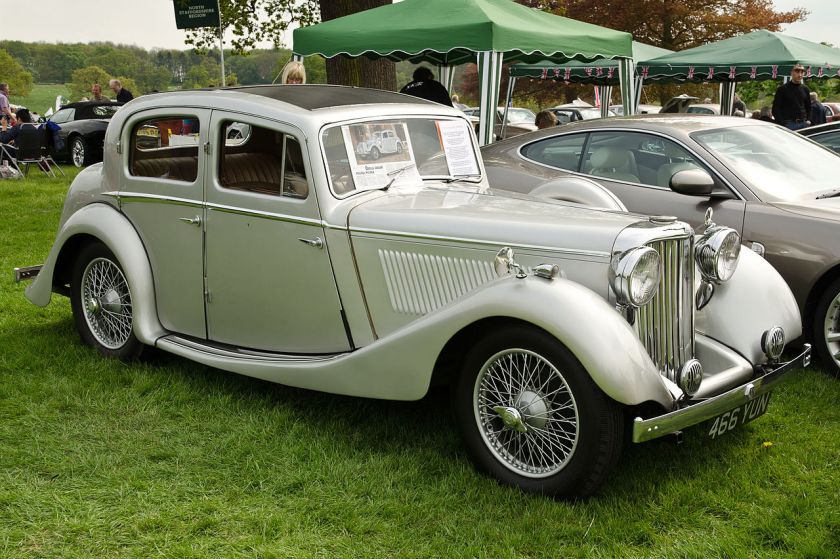
SS Jaguar sports saloon 1937
|
|
| Overview | |
| Production | 1935–1949 10,980 made |
| Body and chassis | |
| Body style | 4-door saloon 2-door drophead coupé |
| Powertrain | |
| Engine | 1,608 cc (1.6 l) I4 1,776 cc (1.8 l) I4 Standard |
| Transmission | 4-speed manual |
| Dimensions | |
| Wheelbase | 112.5 in (2,860 mm) |
| Length | 173 in (4,390 mm) |
| Width | 65.5 in (1,660 mm) |
| Height | 60 in (1,520 mm) |
The smallest model of the range originally featured a 1608 cc side valve Standard engine but from 1938 this was replaced by a 1776 cc overhead-valve unit still from Standard who also supplied the four-speedmanual transmission.
Pre-war the car was available as a saloon or drophead coupé but post war only the closed model was made. Up to 1938 body construction on all the models was by the traditional steel on wood method but in that year it changed to all steel. Performance was not a strong point but 70 mph (113 km/h) was possible: the car featured the same cabin dimensions and well-appointed interior as its longer-engined brothers.
Despite its lack of out-and-out performance, a report of the time, comparing the 4-cylinder 1½-litre with its 6-cylinder siblings, opined that the smallest-engined version of the car was “as is often the case … the sweetest running car” with a “big car cruising gait in the sixties”.
Mechanically operated brakes using a Girling system were fitted.
1935-1948 SS Jaguar and Jaguar 2½ Litre
| SS Jaguar 2½ Litre Jaguar 2½ Litre |
|
|---|---|
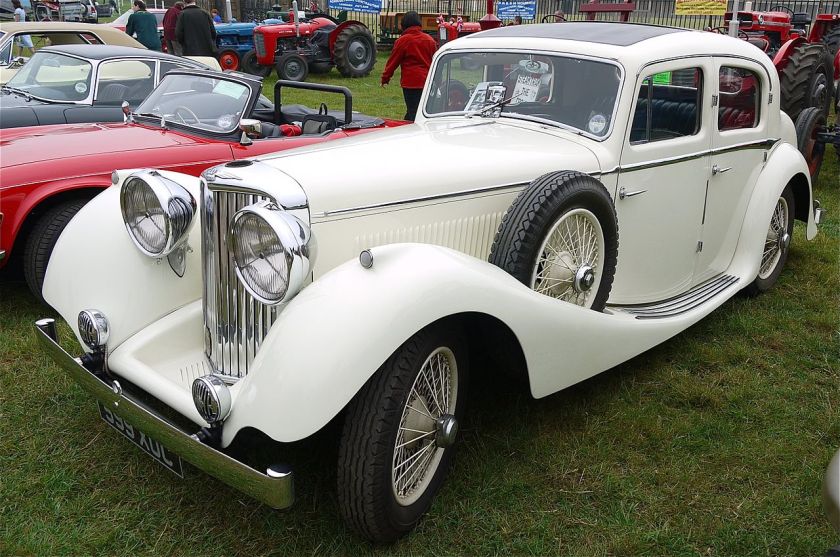
SS Jaguar sports saloon 1936
|
|
| Overview | |
| Production | 1935–1948 6281 made |
| Body and chassis | |
| Body style | 4-door saloon 2-door drophead coupé |
| Powertrain | |
| Engine | 2,664 cc (2.7 l) I6 |
| Dimensions | |
| Wheelbase | 1935–1937: 119 in (3,020 mm) 1938–1948: 120 in (3,050 mm) |
| Length | 186 in (4,720 mm) |
| Width | 66 in (1,680 mm) |
Again the engine was sourced from Standard but had the cylinder head reworked by SS to give 105 bhp. Unlike the 1½ Litre there were some drophead models made post-war.
The chassis was originally of 119 in (3,020 mm) but grew by an inch (25 mm) in 1938 to 120 in (3,050 mm). The extra length over the 1½ Litre was used for the six-cylinder engine and the passenger accommodation was the same size.
1937-1948 SS Jaguar and Jaguar 3½ Litre
| SS Jaguar 3½ Litre Jaguar 3½ Litre |
|
|---|---|
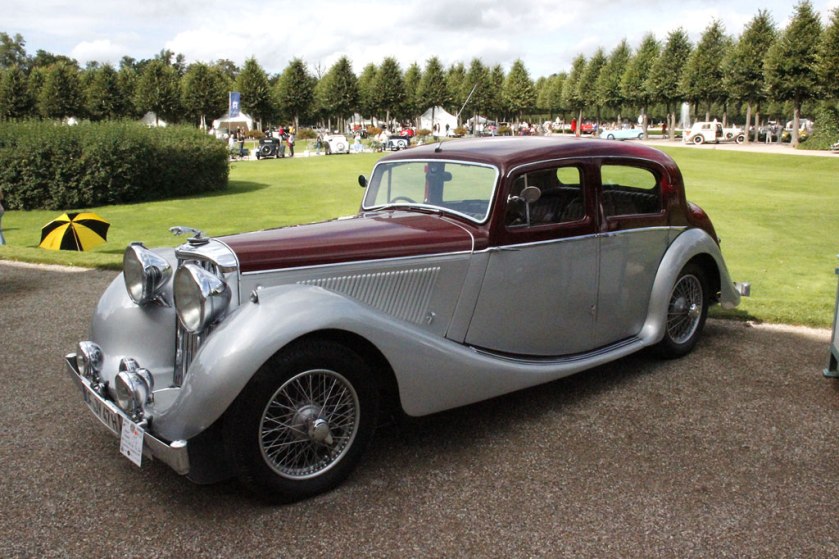
Jaguar sports saloon 1947
|
|
| Overview | |
| Production | 1937–1948 3162 made |
| Body and chassis | |
| Body style | 4-door saloon 2-door drophead coupé |
| Powertrain | |
| Engine | 3,485 cc (3.5 l) I6 |
| Dimensions | |
| Wheelbase | 120 in (3,050 mm) |
| Length | 186 in (4,720 mm) |
| Width | 66 in (1,680 mm) |
The 3½ Litre, introduced in 1938, was essentially the same body and chassis as the 2½ Litre but the larger 125 bhp engine gave better performance but at the expense of economy. The rear axle ratio was 4.25:1 as opposed to the 4.5:1 on the 2½ Litre.
- 1937–1948 3½ Litre saloon
- 1948–1951 Mark V
1948-1951 Jaguar Mark V
| Jaguar Mark V | |
|---|---|
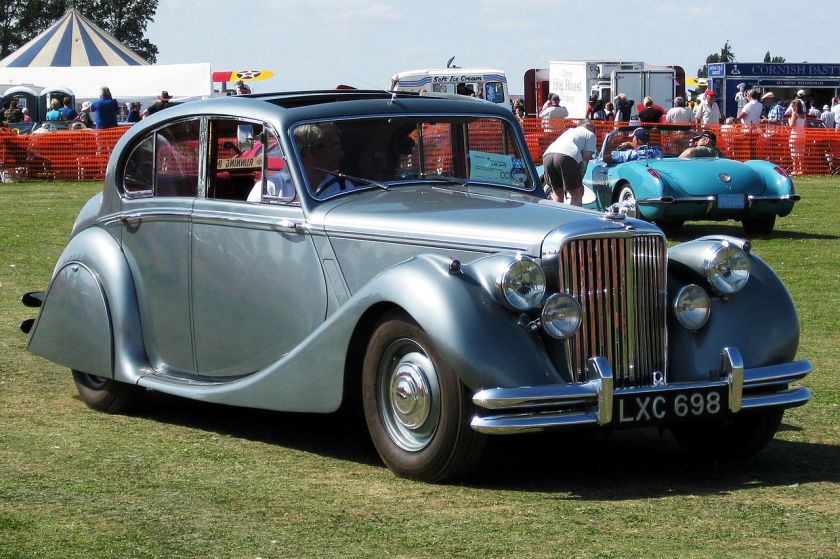
3½-litre saloon
first registered November 1950 |
|
| Overview | |
| Manufacturer | Jaguar Cars |
| Production | 1948–1951 10,466 |
| Body and chassis | |
| Body style | saloon, drophead coupé |
| Powertrain | |
| Engine | 2664 cc or 3485 cc straight-6pushrod ohv |
| Transmission | four-speed manual |
| Dimensions | |
| Wheelbase | 120 in (3,048 mm) |
| Length | 187.5 in (4,762 mm) |
| Width | 69.5 in (1,765 mm) |
| Height | 62.5 in (1,588 mm) |
| Chronology | |
| Predecessor | Jaguar 2½ Litre & 3½ Litre saloons |
| Successor | Jaguar Mark VII |
The Jaguar Mark V (pronounced mark five) is an automobile which was built by Jaguar Cars Ltd from 1948 to 1951.
The Mark V was launched at the 1948 London Motor Show at the same time as the XK120, with which it shared a stand. However, the Mark V vastly outsold the XK120 by roughly 5,000 cars per year as compared to 2,000 cars per year for the XK120. While the XK120 had a new overhead-camshaft XK engine, the Mark V retained the 1936 driveline including the “Jaguar” overhead-valve pushrod straight-6 2½L and 3½L units for which the company was renamed after the war. No 1½L version was offered. Claimed power output in this application was 104 bhp (78 kW) for the 2664 cc Mark V and 126 bhp (94 kW) for its more popular 3486 cc sibling. The chassis was new with independent front suspension by double wishbones and torsion bar, an arrangement that would be used by Jaguar for many future vehicles. It also had hydraulic brakes, which Jaguar had been slow to adopt compared to other manufacturers, and an all pressed steel body.
The styling of the car followed prewar SS-Jaguar lines with upright chrome grille and the leaping Jaguar radiator cap mascot became available as an option. There is a distinct hint of the recently modernised Bentley look in the style of the front grill.
The wheels were 16-inch (410 mm) steel-disc type, significantly smaller than the 18-inch (460 mm) ones on the MK IV. From the side, a distinctive styling touch was a “tuck in” curve at the base of the rear window following the curved profile of the side glass. Rear-wheel spats (fender skirts) were standard. There was also a drophead coupé version which is now highly sought after.
A 3½ litre car tested by The Motor magazine in 1949 had a top speed of 90.7 mph (146.0 km/h) and could accelerate from 0–60 mph (97 km/h) in 20.4 seconds. Jaguar’s inimitable test engineer Norman Dewis used a Mark V regularly. Recently asked about the top speed he saw in his car, he commented that he verified 90 mph once, but the thrill of the moment did not encourage repeating the feat. A fuel consumption of 18.2 miles per imperial gallon (15.5 L/100 km; 15.2 mpg-US) was recorded. The test car cost £1263 including taxes.
Production figures were:
- 2½ litre saloon 1647
- 2½ litre coupé 28
- 3½ litre saloon 7814
- 3½ litre coupé 977
In 1951 the Mark V was replaced by the Jaguar Mark VII. The Mark VII had the same 10-foot (3.0 m)wheelbase as the Mark V, but a longer and more streamlined-looking body, which continued in production with little outward change through the Jaguars Mark VIII and Mark IX until 1961.
The Mark V name
The origin of the Mark V name is somewhat mysterious as there had been no Mk I to IV Jaguars and the MK IV designation was only given to its predecessor after the launch of the Mk V. It was perhaps a nod to Bentley who built 11 advanced Mark V saloons in 1939, resumed with the Mark VI in 1946-52 and dropped the “Mark” naming thereafter while Jaguars continued with the Mark VII to X.
- 1951–1957 Mark VII (& VIIM)
1951-1957 Jaguar Mark VII
| Jaguar Mark VII Jaguar Mark VII M |
|
|---|---|
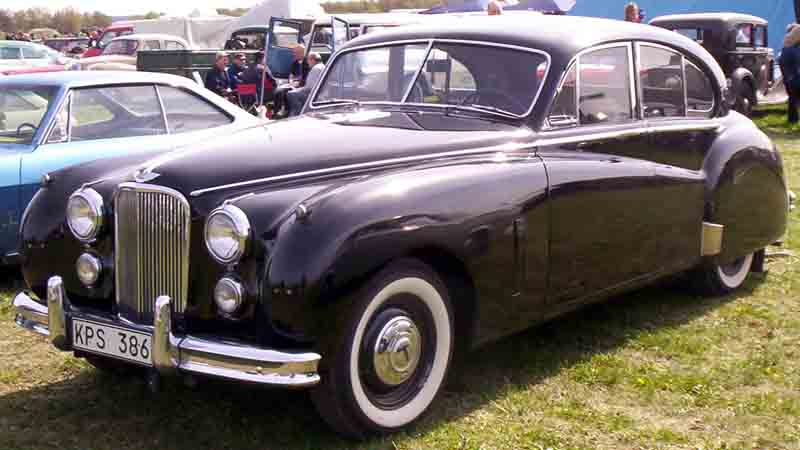 |
|
| Overview | |
| Manufacturer | Jaguar Cars |
| Production | 1950–1956 30,969 produced |
| Body and chassis | |
| Class | Large luxury car |
| Body style | 4-door saloon |
| Powertrain | |
| Engine | 3442 cc I6 , 160 bhp (119.3 kW) (1951–1954) 3442 cc I6, 190 bhp (141.7 kW) (1954–1956) |
| Dimensions | |
| Wheelbase | 120 in (3,048 mm) |
| Length | 196.5 in (4,991 mm) |
| Width | 73 in (1,854 mm) |
| Curb weight | 3,696 lb (1,676 kg) MarK VII 3,724 lb (1,689 kg) MarK VII M |
| Chronology | |
| Predecessor | Jaguar Mark V |
| Successor | Jaguar Mark VIII |
The Jaguar Mark VII is a large four-door luxury car produced by Jaguar Cars of Coventry from 1951 to 1956. Launched at the 1950 London Motor Show as the successor to the Jaguar Mark V, it was called the Mark VII because there was already a Bentley Mark VI on the market. A version of the Jaguar Mark V with the XK engine had been designated as the Mark VI, but it is thought that only two were built. The Mark VII achieved several successes in racing and rallying.
Jaguar Mark VII 1950–1954
The Mark VII chassis came from the Jaguar Mark V and the wheelbase remained the same at (10 feet (3,048.0 mm)). The new model’s body looked more streamlined, with integrated headlights and mudguards, a two-piece windscreen, and longer rear overhang. As on the Mark V, the rear wheels were partially covered by removable spats.
Whereas the Mark V had a prewar engine originally developed by the Standard Motor Company, the Mark VII was powered by the newly developed XK engine. First seen in production form in the 1948 XK120, the 3442 cc straight-six provided 160 bhp (119.3 kW), the same as in the XK120, and the saloon‘s claimed top speed was over 100 mph (160 km/h).
When the car was being developed Jaguar thought it would find most of its customers overseas, mainly because UK car tax at that time penalised buyers of larger-engined cars. However it went into production just as Britain’s postwar economic austerity began to ease, and in 1951 the car’s enthusiastic reception in both the British and American markets prompted Jaguar to relocate production to larger premises, at the Browns Lane plant, which had been built for wartime production as a shadow factory and was now available for immediate use.
The published performance figures for the Mark VII were based on the standard 8:1 compression ratio, but as this was unsuitable for the UK market’s low-octane Pool petrol a 7:1 engine was optional. British motoring magazines tested the car’s performance with the higher compression ratio, using the Ostend to Brussels autoroute in Belgium, where 80 octane fuel was available. A Mark VII tested by The Motor in 1952 had a top speed of 101 mph (163 km/h), accelerated from 0–60 mph (97 km/h) in 13.7 seconds and returned 17.6 miles per imperial gallon (16.1 L/100 km; 14.7 mpg-US). The test car cost £1693 including taxes.
By the time the Mark VII was upgraded to M specification in 1954, 20,908 had been produced.
Jaguar Mark VII M 1954–1956
The Mark VII M was launched at the London Motor Show in October 1954. Although the engine continued with the same capacity and 8:1 compression ratio, it was uprated to 190 bhp (141.7 kW), giving the car a claimed top speed of 104 mph (167 km/h).
The four-speed manual gearbox was standard, while the Borg Warner automatic, introduced in 1953 and hitherto available only on exported Mark VIIs, now became optional for British buyers.
Distinguishing the Mark VII M from its predecessor, circular grilles over the horns were installed below the headlights in place of the former integrated auxiliary lamps, which were moved slightly further apart and mounted on the bumper. Both bumpers now wrapped further around the sides of the car.
In 1956, with the advent of the Suez Crisis Britain anticipated fuel rationing, and bubble cars appeared on the streets. Jaguar switched focus to their smaller saloons (the Mark I 2.4 had been introduced in 1955), and neither the Mark VII M nor any of its increasingly powerful but fuel-thirsty successors would match the production volumes of the original Jaguar Mark VII. Nevertheless, before it was superseded by the Mark VIII, the Mark VII M achieved 10,061 sales during its two-year production run.
Racing and rallying
Both variants of the Mark VII competed in saloon car races driven by Stirling Moss and others, and an M version won the Monte Carlo Rally in 1956.
Entered by the factory, they won the Daily Express International Trophy Production Touring Car race at Silverstone four years running, twice taking the top three places. Moss was the winning driver in 1952 and 1953; Ian Appleyard in 1954 with Tony Rolt and Stirling Moss 2nd and 3rd; Mike Hawthorn won in 1955, from his teammates Jimmy Stewart and Desmond Titterington in 2nd and 3rd; and Ivor Bueb in 1956, with the French journalist and racing driver Paul Frère 4th.
In 1954 Jaguar constructed a lightweight Mark VII M, road-registered KRW 621, using magnesium body panels, D-type engine, Dunlop disc brakes and modified suspension. Although built as a competition car, it never participated in contemporary events.
The winner of the 1956 Monte Carlo Rally was a Mark VII M driven by Ronnie Adams, Frank Biggar, Derek Johnstone.
- 1957–1959 Mark VIII
1956-1958 Jaguar Mark VIII
| Jaguar Mark VIII | |
|---|---|
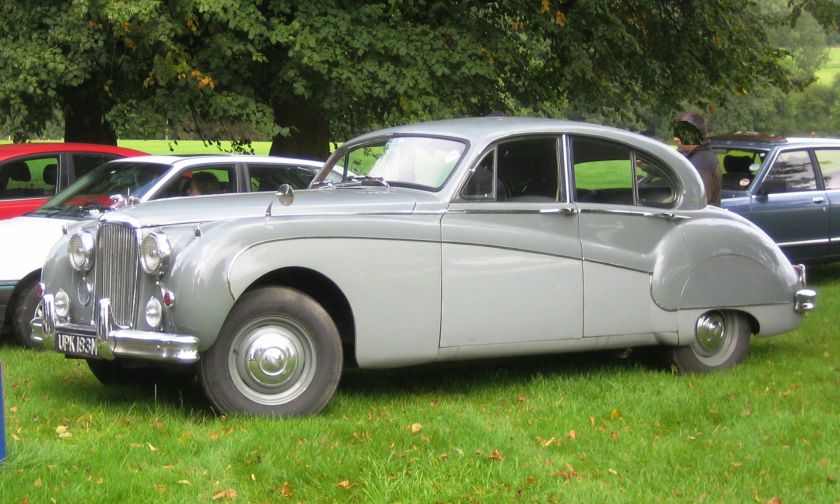 |
|
| Overview | |
| Manufacturer | Jaguar Cars |
| Production | 1956–1958 6,227 produced |
| Body and chassis | |
| Class | Large luxury car |
| Body style | 4-door sedan |
| Powertrain | |
| Engine | 3442 cc, 210 bhp (156.6 kW) |
| Dimensions | |
| Wheelbase | 120 in (3,048 mm) |
| Length | 196.5 in (4,991 mm) |
| Width | 73 in (1,854 mm) |
| Curb weight | 3,752 lb (1,702 kg) |
| Chronology | |
| Predecessor | Jaguar Mark VII |
| Successor | Jaguar Mark IX |
The Jaguar Mark VIII is a large four-door sports sedan introduced by the Jaguar company of Coventry at the 1956 London Motor Show.
The body
The car shared its 10-foot (3.05 m) wheelbase with its predecessor, the Jaguar Mark VII, which outwardly it closely resembled. However, the interior fittings were more luxurious than those of the Mark VII. Distinguishing visually between the models is facilitated by changes to the front grille, the driving or fog lamps being moved from the front panel to the horizontal panel between bumper & front panel, larger rear lamps and most obviously a curved chrome trim strip below the waistline which allowed the factory to offer a variety of two-tone paint schemes. In addition the new car had rear spats that were cut back to display more of the rear wheels and featured a one-piece slightly curved windscreen, where the Mark VII had incorporated a two-piece front screen of flat glass.
Engine and running gear
The Mark VIII inherited from its predecessor the 3442 cc straight-six engine which it shared with the Jaguar XK140 that appeared two years earlier. In the Mark VIII, a modified cylinder head known as the ‘B’ type was used. Although introduced subsequent to the ‘C’ type competition head (as used on the C-Type racer and available as an option on the XK 140) this naming made more sense than might at first appear. The ‘B’ type head used the larger valves of the ‘C’ type head, with the smaller intake port diameter of original XK cylinder head that had been introduced on the MK VII, which was now referred to as the ‘A’ type. The combination of larger valves with the original intake port diameters allowed faster gas flow at low and medium speeds to promote better fuel-air mixing. As the MK VIII was not likely to be revved as high as the C-Type racers and the XK 140’s equipped with the ‘C’ type head the reduction in flow at high rpm’s was not seen to be a disadvantage.
Engines equipped with the ‘A’ type head were advertised at 160 bhp (119.3 kW); the MK VIII with the ‘B’ type head were advertised at 190 bhp (141.7 kW), and engines with the ‘C’ type head at 210 bhp (156.6 kW):. The ‘B’ type head was painted a light blue to identify it.
The modified head supported by twin SU carburetors, and employing a manual four-speed transmission, advertised engine output was now increased to 190 bhp (141.7 kW): the claimed top speed in excess of 106 mph (170 km/h) was considered impressive, given the car’s bulk. Transmission options included overdrive or a Borg Warner three-speed automatic box.
Commercial
After a two year production run of 6,227 units the Mark VIII was replaced by the Jaguar Mark IX.
In January 1958, a Mk VIII Jaguar, driven by M. Dunning and J. M. Cash, won first place in the Automatic Transmission class in the Australian Mobilgas Economy Run, which was an endurance rally of 16,250km starting in Melbourne and circumnavigating the Australian continent.
- 1959–1961 Mark IX
1959-1961 Jaguar Mark IX
| Jaguar Mark IX | |
|---|---|
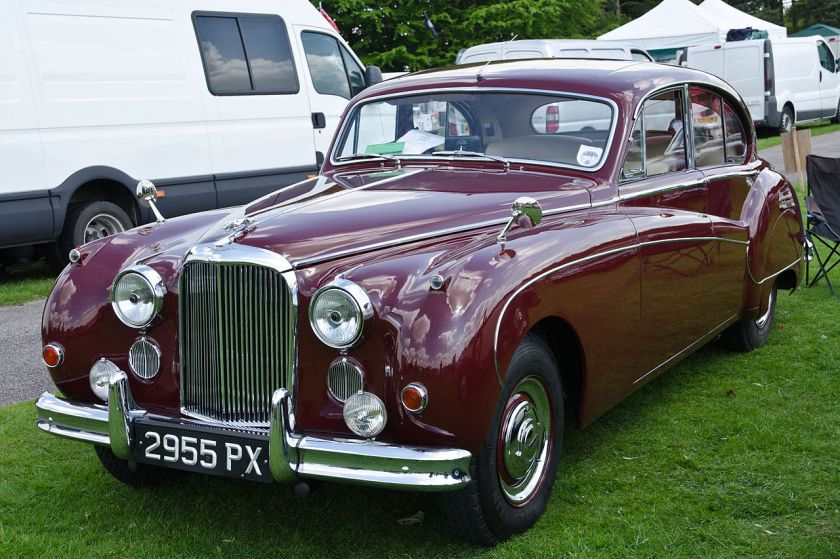
3.8 litre
first registered April 1960 |
|
| Overview | |
| Manufacturer | Jaguar Cars |
| Production | 1959–1961 10,009 produced |
| Body and chassis | |
| Class | Large luxury car |
| Powertrain | |
| Engine | 3781 cc, 220 hp (164 kW) I-6 |
| Dimensions | |
| Wheelbase | 120 in (3,048 mm) |
| Length | 196.5 in (4,990 mm) |
| Width | 75 in (1,900 mm) |
| Height | 63 in (1,600 mm) |
| Curb weight | 4,000 lb (1,800 kg) |
| Chronology | |
| Predecessor | Jaguar Mark VIII |
| Successor | Jaguar Mark X |
The Jaguar Mark IX (pronounced mark nine) is a large luxury saloon car produced by Jaguar Cars between 1959 and 1961. It replaced the previous Mark VIII. The early versions were identical in exterior appearance to the Mark VIII except for the addition of a chrome “Mk IX” badge to the boot lid. Later versions had a larger tail-lamp assembly with the addition of an amber section for traffic indication, visually similar to the tail-lights of the smaller Mark 2 Jaguar sedan. It was replaced by the lower and more contemporary-styled Mark X in 1961.
The Mark IX was popular as a ceremonial car for state dignitaries. When Charles de Gaulle paid a state visit to Canada in 1960, the official cars for the motorcade were Mark IX Jaguars, rather than Cadillacs or Lincolns. The English Queen Mother had a Mark VII Jaguar which was progressively upgraded to be externally identical to the later Mark IX. The Nigerian government bought forty Mark IXs, painted in the Nigerian state colours of green and white. The large Jaguars of the 1950s were sufficiently popular in western Africa that “Jagwah” survives in as a colloquialism for “smart man-about-town”.
In the luxury car market, the Jaguar Mk IX was very competitively priced, selling for ₤1995 with manual gearbox, ₤2063 with overdrive, and ₤2163 with automatic transmission, which was less than half the price of similar competitors.
Features
Standard transmission was a four-speed manual system: options included overdrive, but most cars were built with a Borg Warner three-speed automatic box.
Internally, an enlarged-bore 3.8 L (231 in³), 220 bhp (164.1 kW) DOHC straight-6 replaced the previous 3.4 L (210 in³) 190 bhp (141.7 kW) unit. The B-type head of the Mark VIII was retained, but with a chamfer at the bottom of the combustion chamber to accommodate the enlarged bore. Twin HD6 1.75″ SU carburettors were fitted. A smaller electromagnetically controlled auxiliary carburettor was placed between the main pair of carburettors to act as a choke. It often proved troublesome in operation and many were converted to manual switching . Standard compression ratio was 8:1, but a higher performance 9:1 compression ratio was also available, as was a 7:1 compression ratio for export markets, such as Africa, where quality of petrol was sometimes a problem.
The Mark IX was the first production Jaguar to offer four-wheel servo-assisted Dunlop disc brakes and recirculating ball power steering, which were now standard equipment. The brake system included a vacuum reserve tank to preserve braking in the event that the engine stalled. On models with automatic transmission, the brakes were equipped with an electromagnetic valve that maintained brake pressure at rest when the brake pedal was released to prevent the car from rolling back on an incline, hence its name “Hill Holder”. The Hill Holder was often troublesome (failing to release the brakes when the accelerator was depressed) and was disconnected on most cars without ill effect.
The power steering was driven by a Hobourn-Eaton pump, operating at 600-650 psi. It was attached to the back of the generator and allowed the steering to be geared up to 3.5 turns lock-to-lock as against the 4.5 turns for the Mark VII and VIII models.
Unlike the Mark VII and VIII predecessors, the Borg Warner DG automatic gearbox started in first gear and had a dash-mounted switch to allow second gear to be held indefinitely. Once in third gear, a series of clutches engaged to allow direct drive rather than through the torque converter.
The torsion bar independent front suspension and leaf-sprung rear live axle were retained from the Mk VIII, which, in turn, was first used in the 1949 Mark V.
Final drive was 4.27:1, (4.55:1 when overdrive was fitted).
The sunshine roof became a standard fitting for the UK market. The interior was in the same luxurious mode with extensive use of leather, walnut wood trim and deep pile carpet. A range of single and duo-tone paint schemes was offered.
Performance
A car with automatic transmission tested by the British magazine The Motor in 1958 had a top speed of 114.4 mph (184.1 km/h) and could accelerate from 0–60 mph (97 km/h) in 11.3 seconds. A fuel consumption of 15.2 miles per imperial gallon (18.6 L/100 km; 12.7 mpg-US) was recorded. The test car cost £2162 including taxes of £721. In addition, the Mark IX attained 30 mph in 4 seconds, and 100 mph in 32.5 secs. It covered the standing mile in less than 31 secs.
Classic racing circuit
The Mark IX’s power and good brakes for a vehicle of the era, together with its undoubtedly impressive aesthethic appearance makes it quite a common choice for classic car circuit racing, such as at the Goodwood Circuit‘s Revival meetings.
- 1961–1966 Mark X
1961-1970 Jaguar Mark X
| Jaguar Mark X & 420G | |
|---|---|
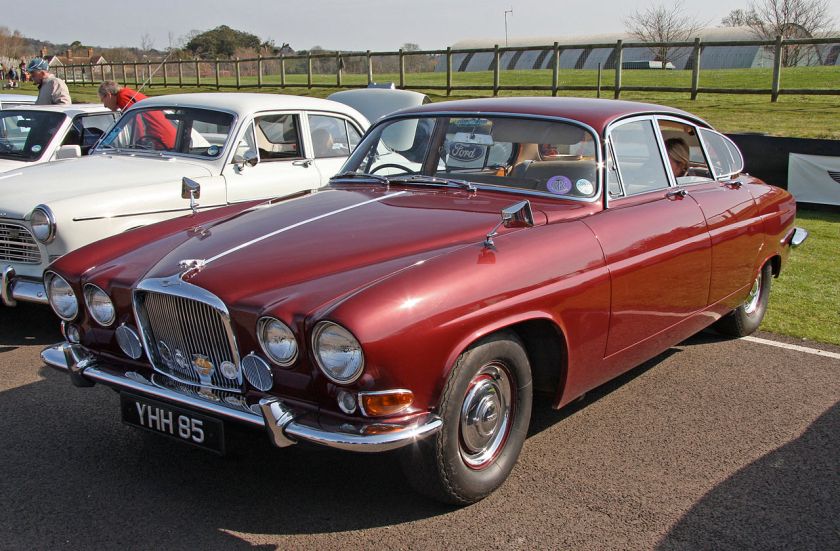
Jaguar Mark X
|
|
| Overview | |
| Manufacturer | Jaguar Cars |
| Production | 1961–1970 13,382 3.8 Litre 5,137 4.2 Litre 5,763 420G |
| Assembly | Coventry, England |
| Body and chassis | |
| Class | Full-size luxury car |
| Body style | 4-door saloon |
| Layout | FR layout |
| Related | Daimler DS420 |
| Powertrain | |
| Engine | 3781 cc XK I6 to 1964 4235 cc XK I6 |
| Dimensions | |
| Wheelbase | 120 in (3,000 mm) |
| Length | 202 in (5,100 mm) |
| Width | 76.3 in(1,938 mm) |
| Height | 54.5 in (1,380 mm) |
| Curb weight | 4,200 lb (1,900 kg) |
| Chronology | |
| Predecessor | Jaguar Mark IX |
| Successor | Jaguar XJ6 |
The Jaguar Mark X (Mark ten) was the top-of-the-range saloon car built by the British manufacturer Jaguar, primarily aimed at the United States market. The Mark X succeeded the Mark IX as the company’s largest saloon model.
Body
The unitary construction body-shell was codenamed “Zenith” during development and this floor pan continued in production long after Mark X production ended, as the DS 420 Limousine. The new style, four headlamps set into rounded front fenders with a vaned grill, first appeared on the Mark X. The interior was the last Jaguar with abundant standard woodwork, including the dashboard, escutcheons, window trim, a pair of large bookmatched fold out rear picnic tables, and a front seat pull-out picnic table stowed beneath the instrument cluster. Later, air conditioning and a sound-proof glass division between the front and rear seats were added as options.
From its introduction until the arrival in 1992 of the low-slung XJ220, the Mark X stood as one of the widest production Jaguars ever built. Asked in 1972 if he thought the Mark X had grown rather too large, Jaguar chairman William Lyons, agreed that it “definitely” had: he opined that the then recently introduced and notably more compact Jaguar XJ6 was, by contrast an “ideal size”.
The substantial doors required helical torsion springs inside the door pillars to enable them to be opened from the inside with an acceptably low level of effort.
Mechanical
The Mark X was the first Jaguar saloon to feature independent rear suspension. It differed from earlier large Jaguar saloons in having 14″ wheels instead of the more common 15″. It used a wider-track version of Jaguar’s IRS unit first seen on the E Type, which was subsequently used on Jaguar vehicles until XJ-S production ended in 1996. Front suspension used double wishbones with coil springs and telescopic dampers. The car initially featured a 3781 cc version of Jaguar’s XK in-line six-cylinder engine. A 9:1 compression ratio was standard, but an alternative 8:1 compression ratio was available as an option. For the London Motor Show in October 1964 the enlarged 4,235 cc unit took over, although the 3.8-litre unit could still be specified until October 1965. Triple SU carburettors were fitted, fed from an AC Delco air filter mounted ahead of the right hand front wheel.
Transmission options were manual, manual with overdrive, automatic or automatic with overdrive. The arrival of the 4.2-litre power unit coincided with the introduction of a newly developed all-synchromesh four-speed gear box replacing the venerable box inherited by the 3.8-litre Mark X from the Mark IX which had featured synchromesh only on the top three ratios. Many domestic market cars and almost all cars destined for the important North American markets left the factory with a Borg Warner automatic gear-box. The 4.2-litre engine’s introduction was also marked by a transmission upgrade for buyers of the automatic cars, who saw the Borg Warner transmission system switched from a DG to a Typ-8 unit. The power train was completed by a Thornton Powr-Lok limited-slip differential.
Stopping power for this heavy car came from power-assisted disc-brakes on all four wheels.
Power-assisted steering was standard, the later 4.2 cars receiving Marles Varamatic Bendix (Adwest) variable ratio steering boxes, designed by an Australian, Arthur Bishop.
420G
For the London Motor Show in October 1966 the Mark X was renamed the Jaguar 420G (not to be confused with the smaller Jaguar 420). The 420G was distinct from the Mark X only with the addition of a vertical central bar splitting the grille in two, side indicator repeaters on the front wings, and a chrome strip along the wing and door panels (two tone paint schemes were also available with the chrome strip omitted). Interior changes included perforations in the central sections of the leather seats, padded dashboard sections for safety, moving the clock to a central position, and the introduction of air conditioning as an option.
A “limousine” version was available, on the standard wheelbase, with a dividing glass screen partition and front bench seat replacing the separate seats of standard cars. The wheelbase was extended by 21″ with the mechanical underpinnings of the car being subtly re-bodied for the 1968 Daimler DS420. This car was built until 1992 and used by many countries in official capacities, and frequently by funeral homes; either with a saloon body for carrying mourners or a hearse body.
Despite running for the same length of time as the Mark X (5 years) the 420G sold in less than a third of the numbers: this lack of popularity and the increasing production of the XJ6 resulted in the 420G being run out of production in 1970.
1968-on Jaguar XJ
| Jaguar XJ XJ6, XJ8, XJ12, Vanden Plas, XJR, Super V8, Supersport |
|
|---|---|
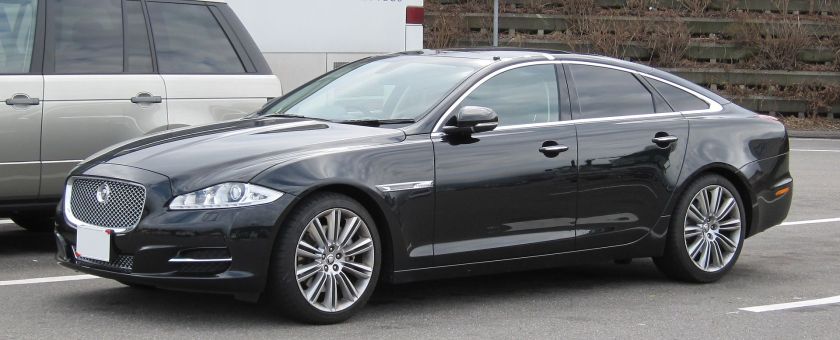 |
|
| Overview | |
| Manufacturer | Jaguar Cars |
| Production | 1968–present |
| Body and chassis | |
| Class | Full-size luxury car |
| Layout | FR layout |
The Jaguar XJ is the name of a series of flagship, full-size, luxury cars sold by the British automobile brand, Jaguar Cars. The XJ line has had a long history, with the first model released in 1968. The original model was the last Jaguar saloon to have had the input of Sir William Lyons, the company’s founder, and the model has been featured in countless media and high profile appearances. The current Jaguar XJ was launched in 2009. It is one of the official cars of the royal families and UK Prime Minister.
Series 1, 2 and 3 (1968–92)
Series 1 (1968–73)
| XJ Series I | |
|---|---|
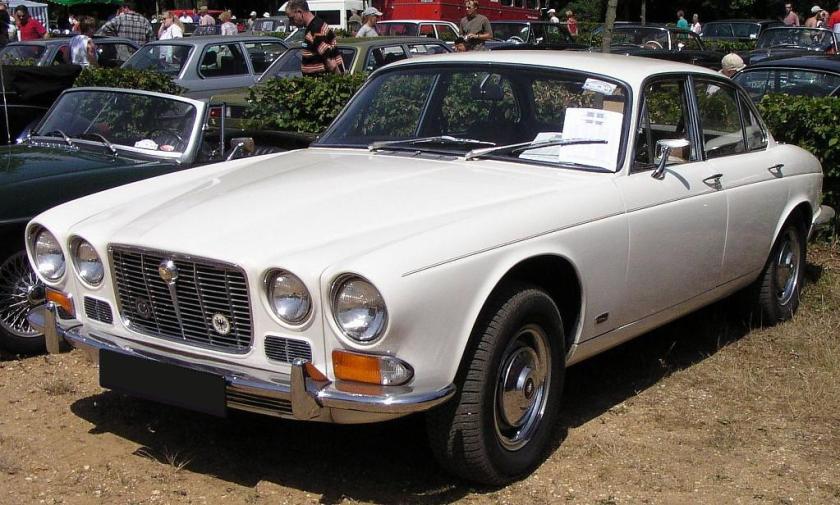 |
|
| Overview | |
| Also called | XJ6, XJ12 Daimler Sovereign Daimler Double-Six |
| Production | 1968–1973 82,126 produced |
| Assembly | Coventry, England Cape Town, South Africa Nelson, New Zealand |
| Body and chassis | |
| Body style | 4-door saloon |
| Powertrain | |
| Engine | 2.8 L XK I6 4.2 L XK I6 5.3 L Jaguar V12 (from 1972) |
| Dimensions | |
| Wheelbase | 108.75 in (2,762 mm) |
| Length | 189.5 in (4,813 mm) |
| Width | 69.75 in (1,772 mm) |
| Height | 52.75 in (1,340 mm) |
| Chronology | |
| Predecessor | Jaguar 240, Jaguar 340 & Daimler 250 Jaguar S-Type Jaguar 420 and Daimler Sovereign Jaguar 420G |
The XJ6, using 2.8 litre (2,790 cc or 170 cu in) and 4.2 litre (4,235 cc or 258.4 cu in) straight-six cylinder versions of Jaguar’s renowned XK engine, replaced most of Jaguar’s saloons – which, in the 1960s, had expanded to four separate ranges. Apart from the engines, other main assemblies carried over from previous models were the widest version of Jaguar’s IRS unit from the Mark X and the subframe mounted independent front suspension first seen in the 1955 2.4 litre with revisions to the geometry.
An upmarket version was marketed under the Daimler brand and called the Daimler Sovereign, continuing the name from the Daimler version of the Jaguar 420.
The car was introduced in September 1968. Power-assisted steering and leather upholstery were standard on the 2.8 L De Luxe and 4.2 L models and air conditioning was offered as an optional extra on the 4.2 L. Daimler versions were launched in October 1969, in a series of television advertisements featuring Sir William. In these spots, he referred to the car as “the finest Jaguar ever”. An unusual feature, inherited from the Mark X and S-Type saloons, was the provision of twin fuel tanks, positioned on each side of the boot / trunk, and filled using two separately lockable filler caps: one on the top of each wing above the rear wheel arches. Preliminary reviews of the car were favourable, noting the effective brakes and good ride quality.
In March 1970 it was announced that the Borg-Warner Model 8 automatic transmission, which the XJ6 had featured since 1968, would be replaced on the 4.2 litre-engined XJ6 with a Borg-Warner Model 12 unit. The new transmission now had three different forward positions accessed via the selector lever, which effectively enabled performance oriented drivers to hold lower ratios at higher revs to achieve better acceleration. “Greatly improved shift quality” was also claimed for the new system.
In 1972 the option of a long-wheelbase version, providing a 4″ increase in leg room for passengers in the back, became available.
The XJ12 version was announced in July 1972, featuring simplified grille treatment, and powered by a 5.3 L V12 engine (coupled to a Borg Warner Model 12). The car as presented at that time was the world’s only mass-produced 12-cylinder four-door car, and, with a top speed “around 140 mph” (225 km/h) as the “fastest full four-seater available in the world today”. Although it had, from the car’s launch, been the manufacturer’s intention that the XJ would take the twelve-cylinder engine, its installation was nonetheless a tight fit, and providing adequate cooling had evidently been a challenge for the engineers designing the installation. Bonnet/hood louvres such as those fitted on the recently introduced twelve-cylinder E Type were rejected, but the XJ12 featured a complex “cross-flow” radiator divided into two separated horizontal sections and supported with coolant feeder tanks at each end: the engine fan was geared to rotate at 1¼ times the speed of the engine rpm, subject to a limiter which cut in at a (fan) speed of 1,700 rpm. The fuel system incorporated a relief valve that returned fuel to the tank when pressure in the leads to the carburetters exceeded 1.5 psi to reduce the risk of vapour locks occurring at the engine’s high operating temperature, while the car’s battery, unusually, benefited from its own thermostatically controlled cooling fan.
3,235 of these first generation XJ12s were built. As with the six-cylinder cars, an upmarket version, this time called the Daimler Double-Six, became available later, reviving the Daimler model name of 1926–1938.
| Model | Production |
|---|---|
| Jaguar XJ6 2.8 swb | 19,322 |
| Jaguar XJ6 4.2 swb | 59,077 |
| Jaguar XJ6 4.2 lwb | 574 |
| Jaguar XJ12 swb | 2,474 |
| Jaguar XJ12 lwb | 754 |
| Daimler Sovereign 2.8 | 3,233 |
| Daimler Sovereign 4.2 swb | 11,522 |
| Daimler Sovereign 4.2 lwb | 386 |
| Daimler Double Six swb | 534 |
| Daimler Double Six Vanden Plas | 351 |
| Total Production for Series 1 | 98,227 |
Series 2 (1973–79)
| XJ Series II | |
|---|---|
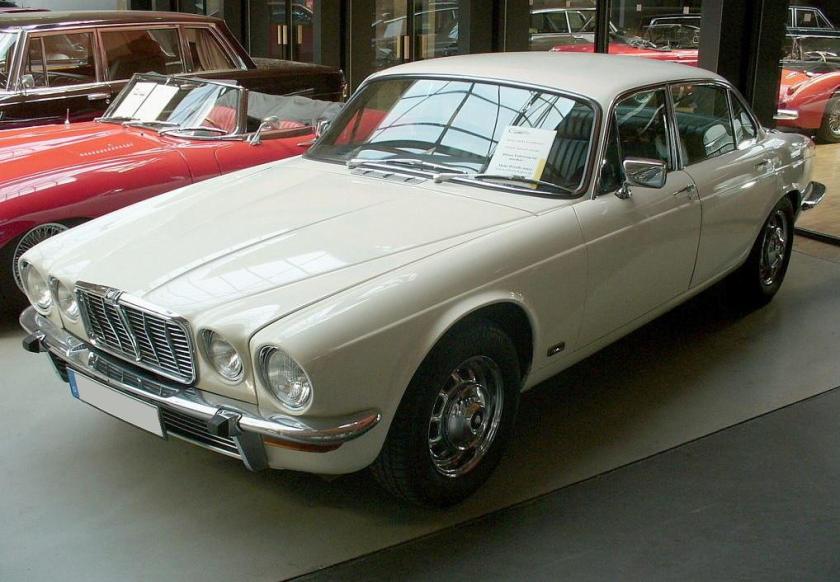 |
|
| Overview | |
| Also called | Jaguar XJ6 & XJ12 Jaguar XJ 3.4, XJ 4.2 & XJ 5.3 [8] Daimler Sovereign Daimler Double-Six |
| Production | 1973–79 (1981) 91,227 produced |
| Assembly | Coventry, England Cape Town, South Africa Nelson, New Zealand |
| Body and chassis | |
| Body style | 4-door saloon |
| Powertrain | |
| Engine | 2.8 L XK I6 3.4 L XK I6 4.2 L XK I6 5.3 L Jaguar V12 engine |
| Dimensions | |
| Wheelbase | 108.75 in (2,762 mm) (swb: only sold until 1974) 112.75 in (2,864 mm) (lwb until 1974: thereafter all sedans) |
| Length | 194.75 in (4,947 mm) (lwb until 1974: thereafter all sedans) |
| Width | 69.75 in (1,772 mm) |
| Height | 54 in (1,372 mm) |
| Kerb weight | 3,841 lb (1,742 kg) |
Commonly referred to as the “Series II”, the XJ line was facelifted in autumn 1973 for the 1974 model year. The 4.2 L I-6 XJ6 (most popular in the United Kingdom) and the 5.3 L V12 XJ12 were continued with an addition of a 3.4 L (3,442 cc or 210.0 cu in) version of the XK engine available from 1975.
The Series II models were known for their poor build quality, which was attributed to Jaguar being part of the British Leyland group along with massive labour union relations problems that plagued most of industrial England in the same time period, and to problems inherent in the design of certain Lucas-sourced components.
Initially the Series II was offered with two wheelbases, but at the 1974 London Motor Show Jaguar announced the withdrawal of the standard wheelbase version: subsequent saloons/sedans all featured the extra 4 inches (10 cm) of passenger cabin length hitherto featured only on the long-wheelbase model. By this time the first customer deliveries of the two-door coupe, which retained the shorter standard-wheelbase (and which had already been formally launched more than a year earlier) were only months away.
Visually, Series II cars are differentiated from their predecessors by raised front bumpers to meet US crash safety regulations, which necessitated a smaller grille, complemented by a discreet additional inlet directly below the bumper. The interior received a substantial update, including simplified heating and a/c systems to address criticisms of the complex and not very effective Series I system.
In April 1975, the North American Series II got a slightly revised set of front bumpers which had rubber over-riders covering the full length of the bumper with embedded turn signals at each end. In 1975 V12 XJS / XJ12L cars and in 1978 the 4.2 6 cyl. XJ6L North American cars got the addition of BOSCH electronic fuel injection in the place of Zenith-Stromberg carburettors.
In May 1977, it was announced that automatic transmission version of the 12-cylinder cars would be fitted with a General Motors three-speed THM 400 transmission in place of the British-built Borg-Warner units used hitherto.
The 1978 UK model range included the Jaguar XJ 3.4, XJ 4.2, XJ 5.3, Daimler Sovereign 4.2, Double-Six 5.3, Daimler Vanden Plas 4.2, Double-Six Vanden Plas 5.3.
In New Zealand, knock-down kits of the Series II were assembled locally by the New Zealand Motor Corporation (NZMC) at their Nelson plant. In the last year of production in New Zealand (1978), a special ‘SuperJag’ (XJ6-SLE) model was produced which featured half leather, half dralon wide pleat seats, vinyl roof, chrome steel wheels and air conditioning as standard. New Zealand produced models featured speedometers in km/h, and the black vinyl mats sewn onto the carpets in the front footwells featured the British Leyland ‘L’ logo.
Though worldwide production of the Series II ended in 1979, a number were produced in Cape Town, South Africa until 1981.
A total of 91,227 Series II models were produced, 14,226 of them with the V12 engine.
Engines
| Years | Type | Capacity | Horsepower |
|---|---|---|---|
| 1973–75 | DOHC I-6 | 2,792 (171 cu. in.) | 140 |
| 1975–79 | DOHC I-6 | 3,442 (210 cu. in.) | 161 |
| 1973–79 | DOHC I-6 | 4,235 (258 cu. in.) | 245/162-186 See Note |
| 1973–79 | SOHC V12 | 5,343 (326 cu. in.) | 265/244 See Note |
Note: HP varies depending on emission standards imposed on particular vehicles
Production count
| Year | XJ6 | XJ12 |
|---|---|---|
| 1973 | 1488 | 168 |
| 1974 | 13526 | 4744 |
| 1975 | 11990 | 2239 |
| 1976 | 12157 | 3283 |
| 1977 | 9043 | 1913 |
| 1978 | 12138 | 3284 |
| 1979 | 1099 | 429 |
| Total | 61,441 | 16,060 |
XJ Coupé
| XJ-Coupé | |
|---|---|
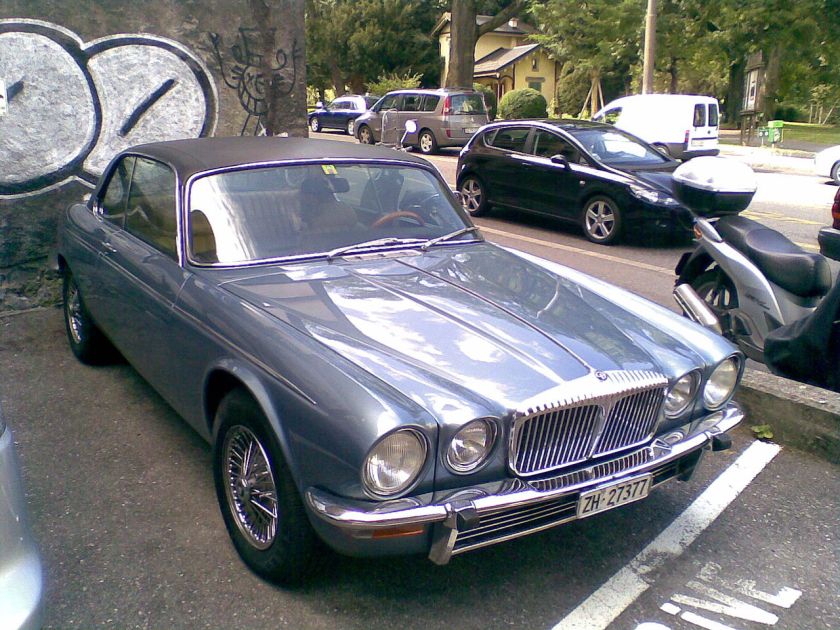
Daimler XJ-C
|
|
| Overview | |
| Also called | XJ-C, XJ6-C, XJ12-C, Daimler Sovereign Coupé Daimler Double-Six Coupé |
| Production | 1975–78 10,487 produced |
| Assembly | Coventry, England |
| Body and chassis | |
| Body style | 2-door coupe |
| Powertrain | |
| Engine | 4.2 L XK I6 5.3 L Jaguar V12 engine |
| Dimensions | |
| Wheelbase | 108.75 in (2,762 mm) |
| Length | 190.75 in (4,845 mm) |
| Width | 69.75 in (1,772 mm) |
| Height | 54.125 in (1,375 mm) |
| Kerb weight | 4,050 lb (1,837 kg) |
A 9,378-car run of two-door XJ coupés with a pillarless hardtop body called the XJ-C was built between 1975 and 1978. The car was actually launched at the London Motor Show in October 1973, but it subsequently became clear that it was not ready for production, and the economic troubles unfolding in the western world at this time seem to have reduced further any sense of urgency about producing and selling the cars: it was reported that problems with window sealing delayed production. XJ coupés finally started to emerge from Jaguar show-rooms only some two years later. The coupé was based on the short-wheelbase version of the XJ. The coupé’s elongated doors were made out of a lengthened standard XJ front door (the weld seams are clearly visible under the interior panels where two front door shells were grafted together with a single outer skin). A few XJ-Cs were modified by Lynx Cars and Avon into convertibles with a retractable canvas top, but this was not a factory product. Lynx conversions (16 in total) did benefit of powered tops. Both six and twelve-cylinder models were offered, 6,505 of the former and 1,873 of the latter. Even with the delay, these cars suffered from water leaks and wind noise. The delayed introduction, the labour-intensive work required by the modified saloon body, the higher price than the four-door car, and the early demise promulgated by the new XJ-S, all ensured a small production run.
All coupes came with a vinyl roof as standard. Since the coupe lacked B-pillars, the roof flexed enough that the paint used by Jaguar at the time would develop cracks. More modern paints do not suffer such problems, so whenever a coupe is repainted it is viable to remove the vinyl. Today many XJ-Cs no longer have their vinyl roof, also removing the threat of roof rust. Some owners also modified their XJ-C by changing to Series III bumpers. This lifted the front indicators from under the bumper and provided built in rear fog lights.
A small number of Daimler versions of the XJ-C were made. One prototype Daimler Vanden Plas version XJ-C was also made, however this version never went into production.
Production Count
| Model \ Year | 1973 | 1974 | 1975 | 1976 | 1977 | 1978 |
|---|---|---|---|---|---|---|
| 4.2l Coupe | 2 | 1 | 2925 | 1746 | 1776 | 37 |
| 5.3l Coupe | – | 11 | 821 | 663 | 329 | 31 |
| Daimler Sovereign Coupe | – | – | 471 | 587 | 613 | 6 |
| Daimler Double Six Coupe | – | 1 | 76 | 149 | 159 | 22 |
| Total | 2 | 13 | 4293 | 3145 | 2877 | 96 |
Grand total = 10,426
Series 3 (1979–92)
| XJ Series III | |
|---|---|
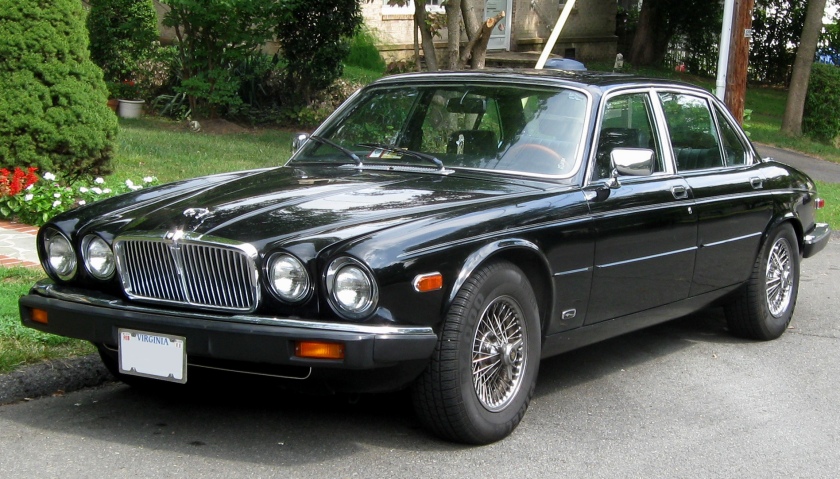 |
|
| Overview | |
| Also called | XJ6, XJ12 Daimler Sovereign Daimler Vanden Plas Daimler Double-Six Double-Six Vanden Plas Jaguar Sovereign (from 1983) Jaguar Vanden Plas |
| Production | 1979–92 132,952 produced |
| Assembly | Coventry, England |
| Body and chassis | |
| Body style | 4-door saloon |
| Powertrain | |
| Engine | 3.4 L XK I6 4.2 L XK I6 5.3 L Jaguar V12 engine |
In late 1979, the XJ was facelifted again, and was known as the “Series III.”
Using the long-wheelbase version of the car, the XJ6 incorporated a subtle redesign by Pininfarina.
Externally, the most obvious changes over the SII were the thicker and more incorporated rubber bumpers with decorative chrome only on the top edge, flush door handles for increased safety, a one-piece front door glass without a separate 1/4 light, a grille with only vertical vanes, reverse lights moved from the boot plinth to the larger rear light clusters and a revised roofline with narrower door frames and increased glass area.
There were three engine variants, including the 5.3 L V12, the 4.2 L straight-six and 3.4 L straight-six. The larger six-cylinder, and V12 models incorporated Bosch fuel injection (made under licence by Lucas) while the smaller six-cylinder was carbureted. The smaller 3.4 L six-cylinder engine was not offered in the US
The short-wheelbase saloon and coupé had been dropped during the final years of the Series II XJ. The introduction of the Series III model also saw the option of a sunroof and cruise control for the first time on an XJ model.
The 1979 UK model range included the Jaguar XJ6 3.4 & 4.2, XJ12 5.3, Daimler Sovereign 4.2 & Double-Six 5.3 and Daimler Vanden Plas 4.2 & Double-Six Vanden Plas 5.3.
In 1981 the 5.3 V12 models received the new Michael May designed “fireball” high compression cylinder head engines and were badged from this time onwards to 1985 as HE (High Efficiency) models.
In late 1981 Daimler Sovereign and Double Six models received a minor interior upgrade for the 1982 model year with features similar to Vanden Plas models. Also for the 1982 model year, a top spec “Jaguar” Vanden Plas model was introduced for the US market – a model designation still used today.
In late 1982 the interior of all Series III models underwent a minor update for the 1983 model year. A trip computer appeared for the first time and was fitted as standard on V12 models. A new and much sought-after alloy wheel featuring numerous distinctive circular holes was also introduced, commonly known as the “pepperpot” wheel.
In late 1983 revision and changes were made across the Series III model range for the 1984 model year, with the Sovereign name being transferred from Daimler to a new top spec Jaguar model, the “Jaguar Sovereign”. A base spec Jaguar XJ12 was no longer available, with the V12 engine only being offered as a Jaguar Sovereign HE or Daimler Double Six. The Vanden Plas name was also dropped at this time in the UK market, due to Jaguar being sold by BL and the designation being used on top-of-the-range Rover-branded cars in the home UK market. Daimler models became the Daimler 4.2 and Double Six and were the most luxurious XJ Series III models, being fully optioned with Vanden Plas spec interiors.
The 1984 UK model range included the Jaguar XJ6 3.4 & 4.2, Sovereign 4.2 & 5.3, Daimler 4.2 & Double Six 5.3.
Production of the Series III XJ continued until 1992 with the V12 engine. In 1992, the last 100 cars built were numbered and sold as part of a special series commemorating the end of production for Canada. These 100 cars featured the option of having a brass plaque located in the cabin. It was the original purchaser’s option to have this plaque, which also gave a number to the car (such as No. 5 of 100, etc.), fitted to the glove box, to the console woodwork or not fitted at all. This brass plaque initiative did not come from Jaguar in Coventry. It was a local effort, by Jaguar Canada staff and the brass plaques were engraved locally.
132,952 Series III cars were built, 10,500 with the V12 engine. In total between 1968 and 1992 there were around 318,000 XJ6 and XJ12 Jaguars produced.
A Jaguar XJ6 alongside Eram Garden in Shiraz, Iran.
Jaguar Sovereign 4.2 in France
1983–86 Jaguar Sovereign 4.2 sedan (Australia)
XJ40, X300, and X308 (1986–2003)
XJ40 (1986–94)
The intended replacement for the Series XJ was code-named XJ40, and development on the all-new car began in the early 1970s (with small scale models being built as early as 1972.) The project suffered a number of delays due to problems at parent company British Leyland and events such as the 1973 oil crisis. The XJ40 was finally introduced in 1986 at the British International Motor Show.
With the XJ40, Jaguar began to place more emphasis on build quality as well as simplification of the XJ’s build process. With 25 per cent fewer body panel pressings required versus the Series XJ, the new process also saved weight, increased the stiffness of the chassis, and reduced cabin noise.
The new platform came with significantly different styling, which was more squared-off and angular than the outgoing Series III. Individual round headlamps were replaced with rectangular units on the higher-specification cars. The interior received several modernisations such as the switch to a digital instrument cluster (although this was eventually discontinued in favour of analogue instruments.)
The six-cylinder XJ40s are powered by the AJ6 inline-six engine, which replaced the XK6 unit used in earlier XJs. The new unit featured a four-valve, twin overhead cam design. In 1993, one year before XJ40 production ended, the V12-powered XJ12 and Daimler Double Six models were reintroduced.
X300 (1994–97)
The X300, introduced in 1994, was stylistically intended to evoke the image of the more curvaceous Series XJ. The front of the car was redesigned significantly to return to four individual round headlamps that provided definition to the sculptured hood. Mechanically, it was similar to the XJ40 that it replaced.
Six-cylinder X300s are powered by the AJ16 inline-six engine, which is a further enhancement of the AJ6 engine that uses an electronic distributorless ignition system. The V12 remained available until the end of the X300 production in 1997 (although it ended one year earlier in the United States market due to problems meeting OBD-II-related emissions requirements.)
Jaguar first introduced the supercharged XJR in X300 production; the first supercharged road car manufactured by the company.
Design of the X300 was directly affected by the Ford Motor Company‘s ownership of Jaguar (between 1990 and 2007). According to Automotive News, this was evident in general “product development processes”, more than the use of Ford components. However, the X300’s traction control system was obtained from the Ford Mondeo and it also featured a Nippondenso air conditioner purchased through Ford channels.
X308 (1997-2003)
With the introduction of the X308 generation in 1997 came a switch from the XJ6 and XJ12 nomenclature to XJ8, reflecting the fact that the X308 cars were powered by a new V8 engine.
The exterior styling of the X308 was similar to the X300 with minor refinements such as a change to oval indicator lenses and round fog lights. The interior was also updated to eliminate the instrument binnacle used on the X300; instead, three large gauges were set into recesses in the walnut-faced dashboard in front of the driver.
The major mechanical change was the replacement of both the inline-six and V12 engines with new eight-cylinder AJ-V8 in either 3.2 L or 4.0 L versions, with the 4.0 L also available in supercharged form. No manual transmission was available, and all X308 models were supplied with a five-speed automatic gearbox.
X350 and X358 (2004–2009)
X350 (2004–2007)
| X350 | |
|---|---|
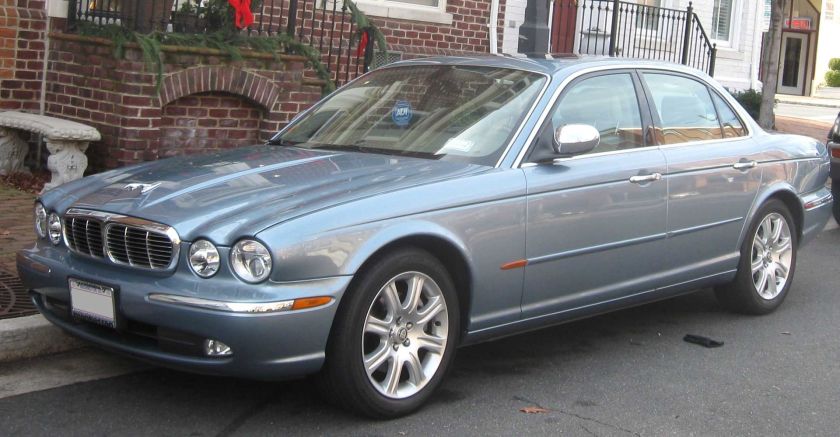 |
|
| Overview | |
| Also called | XJ6, XJ8, Vanden Plas, XJR, Super V8, Daimler Super Eight |
| Production | 2003-2007 |
| Assembly | Castle Bromwich Assembly,Birmingham, England |
| Body and chassis | |
| Body style | 4-door saloon |
| Powertrain | |
| Engine | 3.0 L V6 3.5 L AJ-V8 V8 4.2 L AJ-V8 V8 4.2 L supercharged AJ-V8 V8 2.7 L AJD-V6 V6 Diesel |
| Transmission | 6-speed automatic |
| Dimensions | |
| Wheelbase | SWB: 119.4 in (3,033 mm) LWB: 124.4 in (3,160 mm) |
| Length | SWB: 200.4 in (5,090 mm) LWB: 205.3 in (5,215 mm) |
| Width | 2004-05: 73.2 in (1,859 mm) 2006-07: 83.0 in (2,108 mm) 2008-present: 76.5 in (1,943 mm) |
| Height | SWB: 57 in (1,448 mm) LWB: 57.3 in (1,455 mm) |
| Kerb weight | 3,946 lb (1,790 kg) |
Jaguar introduced the re-engineered third generation XJ (known as X350) in 2003, featuring an all-aluminium body. The new car also featured a V6 engine, an XJ6 badge as well as greater interior and luggage space.
The V8 engine was offered in larger 3.5 and 4.2 litre sizes as well as a supercharged 4.2 Litre. The car’s lighter weight meant the 3.0 Litre V6 was also offered although with the later introduction of the 2.7 litre V6 diesel the V6 petrol version was discontinued (neither V6 petrol nor diesel were available in US markets). A new six-speed automatic gearbox was fitted which was lighter and offered better economy with lock up on all gears and a larger spread of ratios.
Air suspension was fitted all round which provided adaptive damping as well as rear self leveling. Unlike other manufacturers Jaguar did not provide any driver control of ride height or suspension mode which was fully computer controlled. Dynamic stability control as well as traction control were standard.
Two zone climate control was also standard with four zone available on long-wheelbase models. An optional touch screen interface controlled default settings, satellite navigation, the Alpine audio system, and bluetooth telephone. “Jaguar Voice” offered voice control of many functions.
X358 (2007–09)
| X358 | |
|---|---|
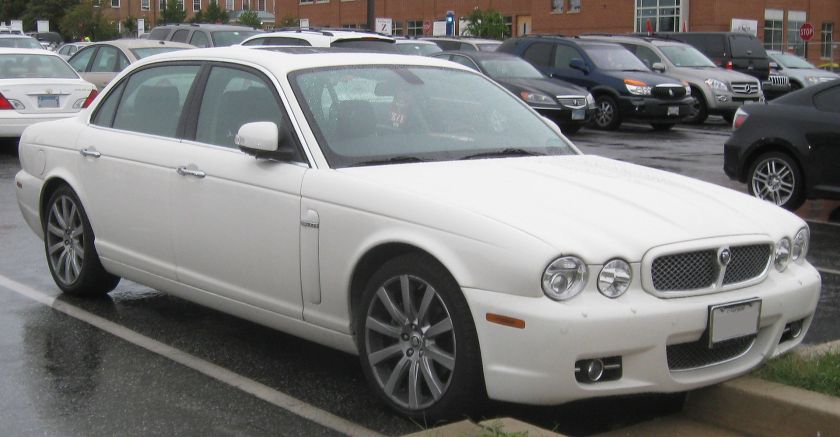 |
|
| Overview | |
| Also called | XJ8, Vanden Plas, XJR, Super V8 |
| Production | 2007–09 |
| Dimensions | |
| Kerb weight | VJ8: 3,770 lb (1,710 kg) VDP: 3,871 lb (1,756 kg) XJR: 3,946 lb (1,790 kg) Super V8 4,006 lb (1,817 kg) |
A face-lifted version of the X350 was unveiled at the end of February 2007. Aesthetically, the main changes were a new lower grille system, with a deeper, more aggressive gape, side air vents similar to those introduced on Ian Callum’s 2005 XK and a small lip spoiler on the bootlid. The changes to the interior included revised seating.
X351 (2009–)
| XJ X351 | |
|---|---|
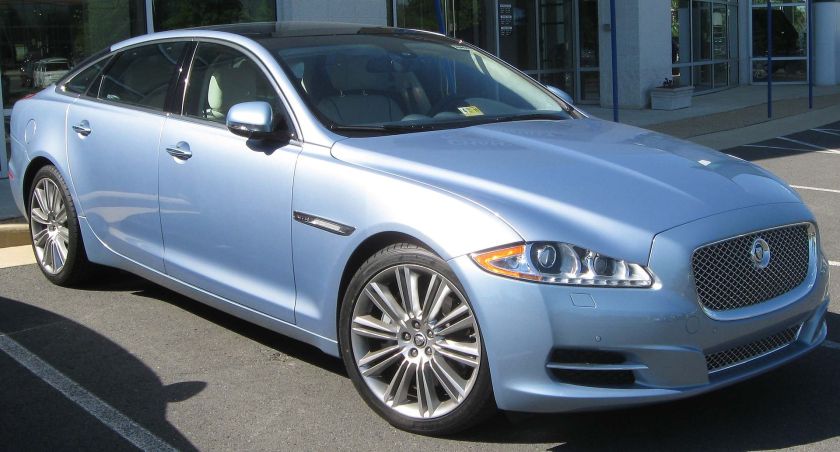 |
|
| Overview | |
| Manufacturer | Jaguar Cars |
| Production | 2009-present |
| Assembly | Castle Bromwich Assembly,Birmingham, United Kingdom Pune, India |
| Designer | Ian Callum, Adam Hatton |
| Body and chassis | |
| Body style | 4-door saloon |
| Powertrain | |
| Engine | 5.0 L 385 PS (283 kW) AJ Gen IIIV8 5.0 L 510 PS (375 kW)supercharged AJ Gen III V8 3.0 L 275 PS (202 kW) V6 Diesel 2.0 L 240 PS (177 kW) R4 Petrol3.0 L 340 PS (250 kW)supercharged AJ V6 |
| Dimensions | |
| Wheelbase | SWB: 119.4 in (3,033 mm) LWB: 124.3 in (3,157 mm) |
| Length | SWB: 201.7 in (5,123 mm) LWB: 206.6 in (5,248 mm) |
| Width | 74.6 in (1,895 mm) |
| Height | 57 in (1,448 mm) |
| Kerb weight | (SWB) Diesel : 1,796 kg (3,960 lb) Petrol : 1,755 kg (3,869 lb) Supercharged: 1,892 kg (4,171 lb)Add 23 kg (51 lb)) for LWB |
| Chronology | |
| Predecessor | XJ X358 |
In July 2009, the newly styled XJ was unveiled at the Saatchi Gallery in London, with Jay Leno and Elle Macpherson unveiling the new car. The unveiling was broadcast live on the Jaguar website.
In keeping with Ian Callum’s new design direction for Jaguar, it is an all-new exterior design and a break from the XJ series mould carried over on all previous generations. It is a longer, wider car that looks much bigger than its predecessor. The front has clear links with the executive car XF, although with slimmer, sleeker lights and a larger, squarer grille and more aggressive appearance. The rear is the contentious part, like nothing Jaguar has shown before. The upright, swooping taillights, nicknamed “cat’s claws”, and black roof panels each side of the rear screen, which aim to hide the XJ’s width, are the most striking aspects. There is also a standard full-length sunroof, that extends all the way back with just a single body-coloured roof panel that the designer likens to bridges on yachts.
The new XJ features an innovative, all-LCD dashboard and console displays. The dashboard can be configured to display various virtual dials in addition to the obligatory speedometer. The console display presents different views to the driver and passenger, including control of a sophisticated video and audio system.
Like several of its predecessors, the X351 is available in both standard and long-wheelbase form, as well as many special editions. Engines are modern units already seen in other JLR products: the 5-litre petrol V8 either normally aspirated or supercharged, or a twin-turbo 3-litre diesel that is predicted to account for most of the sales. For 2013 a 3-litre supercharged V6 was introduced to the line-up, primarily as an alternative to the diesel unit for improved fuel economy.
The X351 received a minor facelift in 2014, primarily upgrading the suspension and rear seat facilities on the long wheelbase versions, but also introducing small cosmetic changes across the range, and making stop-start technology standard on all engines.
Worldwide Sales
| Year | Sales |
|---|---|
| 2009 | 11,977 |
| 2010 | 10,404 |
| 2011 | 15,128 |
| 2012 | 14,988 |
| 2013 | 19,677 |
XJ Numbering of cars and engines
Just prior to World War II, Jaguar, known then as SS Cars, started using a numbering system beginning with the letter X for internal projects. X meaning experimental, XB for military chassis projects and XF to XK for engines. This numbering system has never been consistent and there appear to be many omissions and duplications.
| Number | Project |
|---|---|
| XJ3 | 3.4-litre and 3.8-litre S-Type saloon cars (known to the Pressed Steel Company as ‘Utah’) |
| XJ4 | Designation of the project which led to what was publicly announced as the XJ6 |
| XJ5 | Modifications to the Mark Ten for air conditioning |
| XJ6 | A V12 racing engine with four overhead-camshafts |
| XJ8 | E-type 2+2 version |
| XJ13 | Jaguar sport-racing mid engined prototype |
| XJ16 | Jaguar 420 saloon |
| XJ22 & XJ23 | E-type Series Two |
| XJ27 | The Jaguar XJS |
| XJ40 | Second Generation Jaguar XJ6 (1986–94) (as opposed to Series 2 version of First Generation) |
| XJ41 | Prototype Coupé replacement for the XJ-S |
| XJ42 | Prototype Drophead replacement for the XJ-S |
| XJ50 | Jaguar XJ12 Series Three |
| XJ57 & XJ58 | Jaguar XJ-S 3.6 litre |
| XJ81 | Second Generation Jaguar XJ12 (1993–94) |
| XJ220 | Sports & race car variants developed with Tom Walkinshaw Racing (1992–94) |
- 1972–1992 XJ12
- 1986–1994 XJ6 (XJ40)
- 1993–1994 XJ12 (XJ81)
- 1995–1997 XJ6 & XJ12 (X300 & X301)
- 1998–2003 XJ8 (X308)
- 2004–2007 XJ (X350)
- 2008-2009 XJ (X358)
- 2009–date XJ (X351)
Compact executive
Sports
- 1948–1954 XK120
- 1954–1957 XK140
- 1957–1961 XK150
- 1961–1974 E-Type
- 1975–1996 XJ-S
- 1992–1994 XJ220
- 1997–2006 XK8/XKR (X100)
- 2006–2014 XK (X150)
- 2013–present F-Type
- 2016(announced) F-Pace
Racing and competition
- 1950s C-Type
- 1950s D-Type
- 1960s E-Type Lightweight
- 1985–1992 XJR-5 through XJR-17
- 2009 XFR Bonneville Salt Flats speed record
- 2010 Jaguar RSR XKR GT2
Concept models
- E1A — The 1950s E-Type concept vehicle
- E2 A — The second E-Type concept vehicle, which raced at LeMans and in the USA
- Pirana (1967) — Designed by Bertone
- XJ13 (1966) — Built to race at LeMans, never run
- XK 180 (1998) — Roadster concept based on the XK8
- F-Type (2000) — Roadster, similar to the XK8 but smaller
- R-Coupé (2001) — Large four-seater coupé
- Fuore XF 10 (2003)
- R-D6 (2003) — Compact four-seat coupé
- XK-RR — A high-performance version of last generation XK coupé
- XK-RS — Another performance-spec version of last generation XK convertible
- Concept Eight (2004) — Super-luxury version of the long-wheelbase model of the XJ
- C-XF (2007) — Precursor to the production model XF saloon
- C-X75 (2010) — Hybrid-electric sports car, originally intended for production but cancelled in 2012
- C-X16 (2011) — Precursor to the production model F-Type
- C-X17 (2013) — First ever Jaguar SUV concept
- Project 7 — a 542 bhp V8-powered speedster based on the F-Type and inspired by the D-Type (2013)
Engines
Jaguar has designed in-house four generations of engines.
- Historical engines:
- Current engines:
- Jaguar AJ-V8 engine—V8 (fourth generation Jaguar engine)
- Jaguar AJ-V6 engine—V6 (a variation of a Ford engine)
- Jaguar AJD-V6 engine—V6 (diesel engine designed by Ford)
Motorsport
- See also: Jaguar Racing and Jaguar XJR Sportscars
Jaguar XJ-S won the 1984 European Touring Car Championship
The Jaguar R5 being driven by Mark Webber in 2004—the team’s last season in F1
The company has had major success in sports car racing, particularly in the Le Mans 24 Hours. Victories came in 1951 and 1953 with the C-Type, then in 1955, 1956 and 1957 with the D-Type. The manager of the racing team during this period, Lofty England, later became CEO of Jaguar in the early 1970s. Although the prototype XJ13 was built in the mid-1960s it was never raced, and the famous race was then left for many years.
In 1982, a successful relationship with Tom Walkinshaw‘s TWR team commenced with the XJ-S competing in the European Touring Car Championship, which it won in 1984. In 1985, the TWR XJ-S won the Bathurst 1000 race. In the mid-1980s TWR started designing and preparing Jaguar V12-engined Group C cars for World Sports Prototype Championship races. The team started winning regularly from 1987, and won Le Mans in 1988 and 1990 with the XJR series sports cars. The Jaguar XJR-14 was the last of the XJRs to win, taking the 1991 World Sportscar Championship.
In the 1999, Ford decided that Jaguar would be the corporation’s Formula One entry. Ford bought out the Milton Keynes-based Stewart Grand Prix team and rebranded it as Jaguar Racing for the 2000 season. The Jaguar F1 program was not a success however, achieving only two podium finishes in five seasons of competition between 2000 and 2004. At the end of 2004, with costs mounting and Ford’s profits dwindling, the F1 team was seen as an unneeded expense and was sold to Red Bull energy drinks owner Dietrich Mateschitz, and it became Red Bull Racing. Since 2004 Jaguar has not had an official presence in motorsport.
Notable Jaguar sports racers:
- Jaguar C-Type (1951–1953)
- Jaguar D-Type (1954–1957)
- Jaguar Lightweight E-Type
- Jaguar XJ13
- Jaguar XJR Sportscars
- Jaguar XJR-9 (1988)
- XJ220 (1988)
- XJR-15 (1990)
Electric vehicles
Lotus Cars joined Jaguar, MIRA Ltd and Caparo on a luxury hybrid executive sedan project called “Limo-Green”—funded by the UK Government Technology Strategy Board. The vehicle will be a series plug-in hybrid.
Facilities
Jaguar Land Rover operations are split between several sites, most of which are used for work on both the Jaguar and Land Rover brands.
Current plants
- Whitley Engineering Centre – Jaguar Land Rover’s headquarters and a research and development centre. The older part of this plant was acquired from Peugeot in the 1980s, and was formerly a First World War airfield, an aircraft factory and then a missile factory before being sold to the Rootes Group (later Chrysler Europe).
- Gaydon Engineering Centre – Jaguar Land Rover’s other research and development centre. Formerly an RAF bomber base before being acquired by British Leyland and redeveloped as a vehicle design, development and testing centre. Part of this site is also the Aston Martin headquarters, development centre and factory.
- Castle Bromwich – Jaguar Land Rover’s main Jaguar assembly plant, producing the XF, XJ, XK and F-Type ranges. Originally an aircraft factory during World War Two – Spitfires were built there, it was later acquired by Pressed Steel Fisher and became a vehicle body assembly works, it came under the auspices of Jaguar through the merger with BMC in the 1960s.
- Solihull – Jaguar Land Rover’s principal Land Rover assembly plant. This was originally an aircraft engine plant during World War Two, being used for as a Rover plant after the war. The Jaguar XE will become the first Jaguar car to be assembled at the facility in late 2014, followed by the Jaguar F-Pace crossover from 2016.
- Halewood, Merseyside – Now used by Jaguar Land Rover for Land Rover production. Originally a Ford assembly plant (the Ford Escort being its most prolific model) it was given to Jaguar in 2000 for production of the X-Type. Ford still owns the transmission manufacturing operation at Halewood.
- Wolverhampton Engine Plant – a new £500 million facility located at the i54 site in Staffordshire close to Wolverhampton to build the new Ingenium family of modular diesel and petrol engines. The plant was officially opened by Her Majesty Queen Elizabeth II on Thursday, October 30, 2014.
Future plants
- Ryton-on-Dunsmore – Jaguar Land Rover announced that it will build a new Special Vehicle Operations development centre there in 2016. The site was previously used by Rootes for aircraft production plant for World War Two, and later became the Rootes/Chrysler/Peugeot car plant which was closed in 2006 and has since been completely demolished and the site cleared.
Past Jaguar plants
- Holbrooks Lane, Coventry – by the time Swallow Sidecar Company started using the Jaguar name, they had relocated from Blackpool to Holbrooks Lane in Coventry.
- Browns Lane – The most well-known site for Jaguar production from 1951, it was progressively run down and replaced by Castle Bromwich. Most of the plant has now been demolished and is now the home of Jaguar Land Rover’s heritage centre.
- Radford – originally a Daimler bus plant but was later a Jaguar engine and axle plant. Closed by Ford in 1997 when it moved all Jaguar engine production to its Bridgend facility.
Jaguar and the arts
For some time now Jaguar has been active in the international arts scene. In particular, the company has collaborated with the artist Stefan Szczesny, implementing major art projects. In 2011, Jaguar presented the exhibition series “Shadows”, which involved the installation of Szczesny’s shadow sculptures in Sankt-Moritz, on Sylt and in Saint-Tropez. In 2012, a large number of sculptures, ceramics and paintings were shown in Frankfurt (and mainly in Frankfurt’s Palmengarten).
As part of the collaboration with Szczesny, Jaguar has released the “Jaguar Art Collection”.
